Be a winner
We have two pairs of tickets to give away to readers to see Led Zep’s Robert Plant in Granada




We have two pairs of tickets to give away to readers to see Led Zep’s Robert Plant in Granada



SPAIN has broken its all-time June heat record, with temperatures hitting a blistering 46°C in El Granado, Huelva, near the Portuguese border. The milestone, recorded on Sunday, is still awaiting official confirmation from national weather agency AEMET.
It comes as a fierce heatwave grips southern Europe, placing Portugal on red alert and pushing France and Italy into the low 40s.
Portugal’s meteorological institute has urged locals and tourists – including thousands of Brits on the Algarve – to stay indoors as the mercury rises. Lisbon hit 42°C, while Badajoz, just over the border in Spain, reached 44°C.
Brunt
Inland southern Spain is bearing the brunt, with unofficial readings smashing the previous June record of 39.7°C. On the Costa del Sol, temperatures peaked at 38°C, raising wildfire fears and pressure on cooling systems.
Experts say official figures due this week could confirm it as Spain’s hottest June ever.
Paris reached 41°C yesterday, while Rome roasted at 40°C today.
Mediterranean waters, now up to 5°C above average, are worsening the heat and even threatening to disrupt France’s nuclear power plants.
See Page 3








The style that took Baroque to the extreme and then on to the Americas in our Property Magazine inside




La Linea
building a new terminal at the
airport as part of radical new ‘crossborder conurbation’ with Gibraltar
A BOLD proposal has been laid out to build a new airport terminal on Spanish soil, with the stated aim of converting Gibraltar and La Línea into a shared conurbation of 120,000 people.
Even as the dust is still subsiding on last month’s announcement of a historic deal with the EU – and Spain – La Línea’s city council has revealed its radical ambitions for the Rock in a newly-released strategic memorandum.
Among a number of other proposed measures, the town of 70,000 intends to shake up its urban planning to make room for a second passenger terminal next to Gibraltar’s existing airport.
The project hopes to capitalise on the anticipated disappearance of the physical border and Gibraltar’s effective integration into the Schengen area, which would allow for joint border control and direct flights to Spanish cities for the first time in decades.
The current treaty framework will already see arrivals passing through ‘dual’ custom checks – first with Gibraltar officers and then with Spanish.
A second terminal, located on Spanish soil, could feasibly see the duplication effect inevitable with this compromise eradicated as internal Schengen visi-
By Walter Finch
tors bypass Gibraltar entirely.
According to the La Linea town hall, the deal poses a once-in-a-lifetime opportunity to revitalise the struggling town and make the Campo de Gibraltar –home to Spain’s busiest port in Algeciras – and Gibraltar it self a new transport and logistics hub to rival Malaga, Sevilla and any other regional centre.

Officials ultimately hope to turn this new ‘cross-border conurbation’ into the premier strategic transport hub in the southern Mediterranean.
The town also aims to position itself as a launchpad for industries that complement Gibraltar’s low-tax model — including tech startups, smart tourism ventures and high-value service sectors.
Officials even envisage the expanded airport hosting a so-called Cross-Border Innovation Park, which would serve as a technology cluster designed to attract international companies to the area.


EXPANDING: La Linea wants to transform the region with a second airport terminal
locked each morning with cross-border workers heading to Gibraltar.
of the town’s General Urban Development Plan, calls for the land next to the airport in anticipation of building the terminal.
Officials have also reiterated the necessity of hooking La Linea up to the proposed Algeciras-Nerja coastal rail line – not expected to arrive for a minimum of 16 years, if ever.
Meanwhile, existing public transport options would need to be massively upscaled, with fresh shuttle services provided to handle increased tourist arrivals and local demand.
An expanded airport would put a huge strain on the already overcrowded road network in the area, with the existing A-7 motorway regularly grid-


While increased flights and accessibility to Gibraltar would bring obvious economic benefits in the form of increased tourism and business connections, it would only be feasible with a massive upgrade of the local transport infrastructure
However, despite all the obstacles, La Línea officials believe the terminal would be one of the major steps in fully capitalising on the new Gibraltar deal – yet to be signed or ratified – and unlock the combined economic potential of the two jurisdictions.
It creates what La Linea’s strategic memorandum describes as the need for ‘coordinated planning’ between the two territories as part of a sweeping vision to transform La Línea into a fully integrated partner in a post-Brexit fu-
ture shared with Gibraltar. But it’s a vision that has not been universally welcomed on the Rock.
The development would likely fundamentally alter the airport’s dynamics, as the Spanish terminal becomes the dominant gateway given that in such a hub most passengers would be travelling onwards to Spain rather than remaining in Gibraltar’s small territory.
The plans would naturally see the Spanish town receiving a share of the revenue from the airport on its ways to integrating La Línea and Gibraltar into a ‘single-functioning cross-border conurbation.’




It also triggers fears of ‘sovereignty creep’, and anxiety that over time Spain will slowly disarm Gibraltar of its economic advantages and cultural distinctiveness – until it swallows it up entirely.
NINE of Andalucia’s 10 priciest towns are in Malaga province, with average 80m² apartments costing €320,000. Benahavis tops the list at €5,391 per m², while demand far outstrips supply.
SPAIN and other southern EU countries have criticised a UK-France pact that could force them to take back migrants returned from the UK, warning it risks overburdening first-entry states.
MORE than 300 passengers were stranded for over 14 hours in Toledo after a power failure halted the Murcia-Malaga train, causing major delays and cancellations.
SPANISH MEP Irene Montero has demanded Spain quit NATO and cut ties with the US, condemning both as threats to world peace amid US strikes using Spanish military bases.
A BRITISH man shot dead after a kickabout on the Costa del Sol has been named as 32-year-old Steven Gray from Liverpool. Gray was killed on Easter Monday in Calahonda after leaving a five-a-side match at the Finca Naundrup resort.
Locals described a dramatic shootout near the Club de Sol tennis courts, with up to 10 shots ringing out. Gray is be-
lieved to have fired back before collapsing in the street.
Cops later found a burnt-out Seat Cupra dumped nearby with two pistols inside – thought to be the murder weapons. A manhunt is underway for two hooded hitmen seen fleeing the scene.
The execution is believed to be gang-related, with police probing links to the May 31 assassination of two Scottish gangsters – Eddie Lyons Jnr and Ross Monaghan – who were gunned down outside a bar in Fuengirola.
Spanish authorities are working with UK police after arresting 44-year-old Michael Riley in Liverpool in connection with the double hit.
A LUXURY villa belonging to Marbella mayor Angeles Muñoz’s son
be
in connection with a major Swedish mafia
Marbella mayor’s son could lose luxury villa in mafia trial
By Walter Finch
of leading the Costa del Sol branch of the so-called ‘Mocromafia’.

Police forced entry after a friend reported Amy missing. Her body was found in the bedroom, with multiple hammer blows.
nied any wrongdoing.
in Madrid. Prosecutors want to confiscate Alexander Broberg’s San Pedro home, alleging it was purchased with drug money laundered by his half-brother Joakim Broberg – accused A FEMALE bodybuilder was bludgeoned to death by her husband in a brutal murder-suicide at a luxury flat in Fuengirola. The Colombian victim, Zunilda Hoyos Mendez, 43, had been missing for five days before police discovered her body in the Higueron West complex. Her American husband Jarrod Gelling, 47, also a bodybuilder, was found dead in the bathroom from apparent self-inflicted stab wounds.
Joakim faces 18 years in prison and a €30 million fine for trafficking hashish and marijuana from Morocco to Sweden. The €230,000 property is
A YOUNG girl was amongst three family members wounded after gunmen opened fire on their home in Mijas.
The shooting occurred in the Las Lagunas area when neighbours were woken by multiple gunshots and
registered under Panamanian firm Lesley Company INC, set up decades ago by the brothers’ late father Lars Broberg – a Swedish businessman and Muñoz’s husband until his death in 2023.
Prosecutors say the exact sum used to mortgage the home matches the amount allegedly laundered by Joakim, and
immediately alerted emergency services.
Sources close to the investigation confirmed that the shots were fired from the street, apparently targeting the family residence where the victims lived.
The three injured family members were rushed to hospital but are now out of danger.
have asked for the 2019 ownership transfer to Alexander to be annulled. Alexander, who has lived in the villa since 2017, insists he legally inherited it through a donation and de-
A court heard that Lars, accused posthumously of laundering over €7 million, supervised Joakim’s operations and even tipped him off about police wiretaps. “It’s as if he were supervising everything,” a police inspector testified.
Although Joakim is Muñoz’s stepson, Alexander is her biological son, dragging the Partido Popular mayor deeper into the scandal.
Muñoz initially defended her husband and sued elDiario.es over its reporting, but the case was thrown out.
The trial continues at Spain’s National Court.
The couple, who had no children, lived in Dubai and competed internationally. Amy had planned to leave her husband and return to Colombia.

TRAGEDY: Victim and her huband are both dead


AS the record-breaking heatwave took hold spreading its tendrils from the Sahara into Europe, the Olive Press went heat chasing.
Just as storm-chasers like to get up close and personal with tornadoes and hurricanes, we go to death-defying meteorological phenomena, and we have come up with a new one: the heat chaser.
Weather forecasters had already bandied about the possi-
The Olive Press takes a journey from the fire of the costas into the dark boiling interior of Sevilla province
bility of Spain seeing 46C while still in the month of June, and we wanted to be there to feel it hit us in the face.
So we set out for Ecija, a charming Sevillian town of baroque spires affectionately known as the frying pan of Spain. Located in the Guadalquivir

Valley in a geographical depression that traps the oppressive inland heat, Ecija has registered temperatures of over 46C in the peak summer months before (ie. not June).
In fact, it is just down the road from where Spain’s alltime record heat of 47.6C was recorded in Cordoba in August 2021. “It’s criminal the
By Walter Finch
heat that we have to endure here, but we manage,” Marga, Ecija resident born-and-bred, told the Olive Press.
During the peak summer months, as the sun inches its way higher into the sky, the Ecija residents scurry to the shadows.
The day starts full of life and activity. Tables and chairs go out on the broad central square, Plaza España, around 8am –when the temperature is only 30C.
Despite its stunning Moorish remains, baroque towers, palaces, and Roman mosaics, Ecija was all but deserted by 10.30am as the mercury hit 36C.
By midday, the town was a ghost town — like a western scene before a showdown.
But not the Olive Press, in
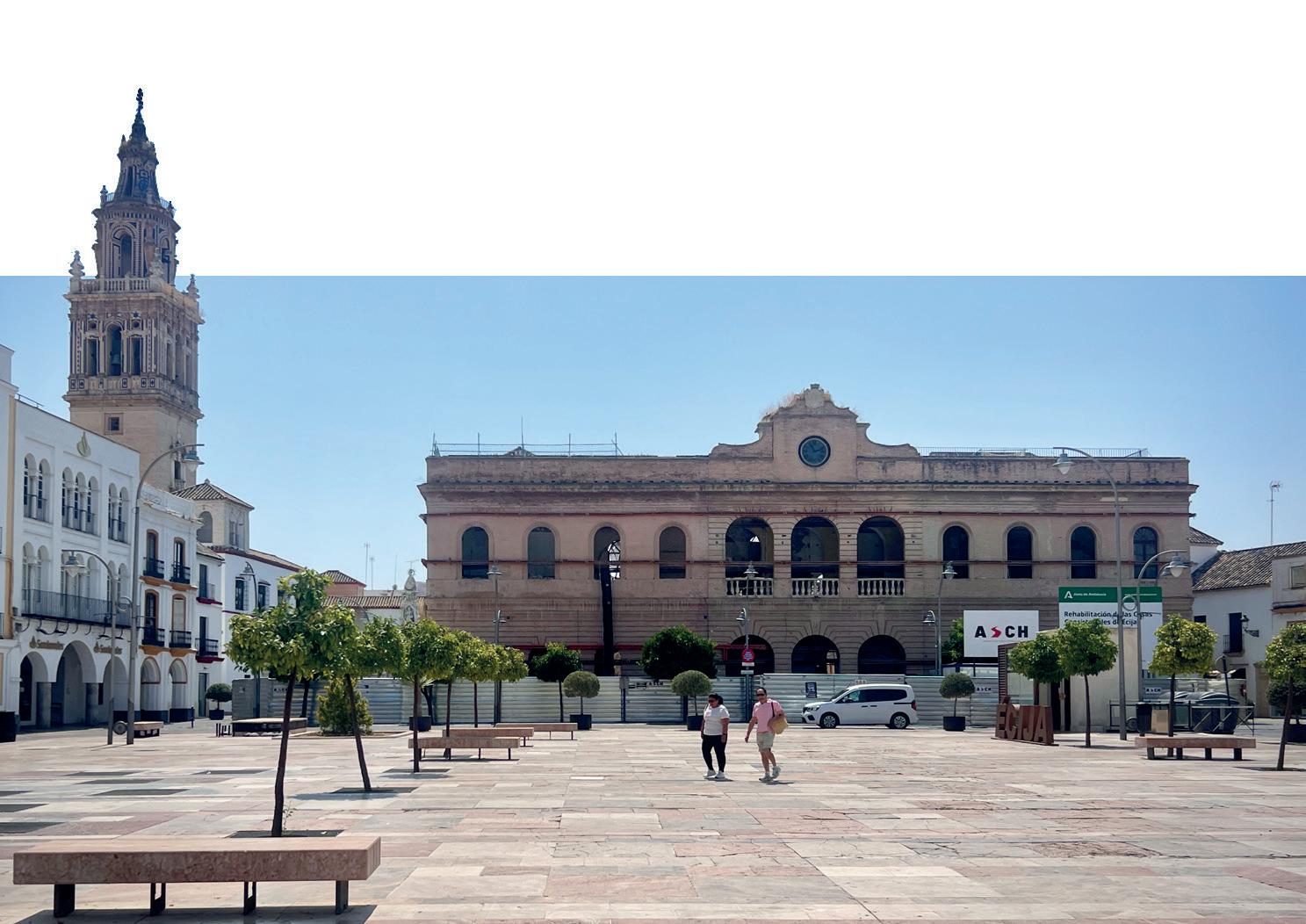
search of understanding how to handle extreme heat in a Spanish summer.
At 2pm, the heat hit 40C — lunch time in Spain, when squares normally buzz with cold drinks and tapas.
The chairs remained empty. Most sought refuge in air-conditioned restaurants.
“I grew up in this but I still suffer,” said Tamara, 24, a waitress.
Is this heatwave anything new?
Locals say no - “It’s the same heat as always,” but “it’s coming earlier now.”
And lo and behold, as I sit nursing an ice cold Verdejo following a splendid lunch at Bar Chico, the news comes through that Spain has broken its heat
UK, Spain, and even Gibraltar natives left scratching their heads – but the monkeys couldn’t care less
READING the headline in the Olive Press - Surrender or Triumph I can’t help but come to the conclusion that like all the rest of Brexit the Gibraltar settlement is a calamitous deal that makes everyone a loser.
But also like Brexit there is a big loser, that would be the UK with a bronze medal, and Spain winning silver, which was more than had been hoped for, especially considering the true inhabitants of ‘Gib’ who in the 2016 EU referendum voted 94.9% in favour of remaining part of the UK.
Everyone with skin in the game here has come up short. Spain wanted the rock back but has had to settle for being allowed to put a customs shack on the border to stamp British passports in and out of the territory. A sort of face-saving deal that means Gibraltar stays British, but at a cost to the Spanish taxpayer.


WORTH A CHEER: At least if you are one of Gib’s Barbary Macaques, but not so much if you are British or Spanish
encounter with some resident apes (actually Barbary macaques) that have been citizens for longer than anyone, after being introduced by the Moors as long ago as the 8th century.
More generally, this outcome is completely bonkers!
On the other side of the fence is the UK and the 35,000 Gibraltar natives - out of a total of 38,000 - who voted to stay part of the UK. No longer can Brits who are resident in the UK drop into the rock nation for a steep climb and an
Did I say everyone’s a loser? I guess that’s not 100% correct; the 300 monkeys probably don’t give a ‘flying macaques pooh’ who’s in charge of policing the border, and Gibraltar’s Business minister, Nigel Feetham is probably a winner too.
And why is young Nigel so keen on the deal? I reckon that might be something about the devil being in the detail. All card-carrying residents of Gibraltar will not only be able to travel passport check free between their homes and the
UK, but they also get a free pass into the Schengen zone (most of the rest of Europe). You have to wonder what price Nigel will soon be putting on a Gibraltar ID card?
I think the Maltese might be getting a bit worried about their lucrative passport side-hustle, which means the island nation’s passports currently go for €690k for one, or €840k for an entire family!
More generally this outcome is completely bonkers. The UK has held sovereignty over the rock since the Treaty of Utrecht 1713 and its people want it to stay that way. I get that Spain feels the rock should be Spanish, but now all it has is the cost of looking after the border, but they still can’t fly the Rojigualda flag over the rock’s 38,000 souls and 300 ape immigrants.
Just another example of why Brexit is a complete basket case of an idea!
record for June – 200km to the west.
It’s recorded in Huelva prov ince in a town called El Grana do… and the mercury nudged 46C.
Over in the frying pan of Spain it’s a mere 43C, and time to try the egg test.

The Olive Press did it before with some success in July five years ago when we fried an egg on the pavement.
But can we do it at 4pm on a hot June day on a bench that is definitely too hot to sit on?
Cracking it onto the burning surface I expect it to sizzle but it doesn’t whiten at the edges or harden its yolk in the centre.
All that’s left is a raw eggy mess on a
bench.
Ecija doesn’t start to come back to life till after 9pm. “Here, we live by night,” explains Romanian Mihail, gearing up for evening. “Yes, it was hard to get used to at first, but it’s only two months a year.”

SUFFER: She may be used to it but Tamara still swelters
Perhaps not. Given the premature nature of this heatwave and the record-breaking June, they might have to extend their endurance in the coming years.
Retired tennis legend Rafa Nadal has been made a marquis by King Felipe in recognition of his huge contribution to Spain.
Nadal, 39, who won 22 Grand Slams, will become Marquis of Llevant de Mallorca. He was among six people honoured to mark the King’s 10th anniversary on the throne.
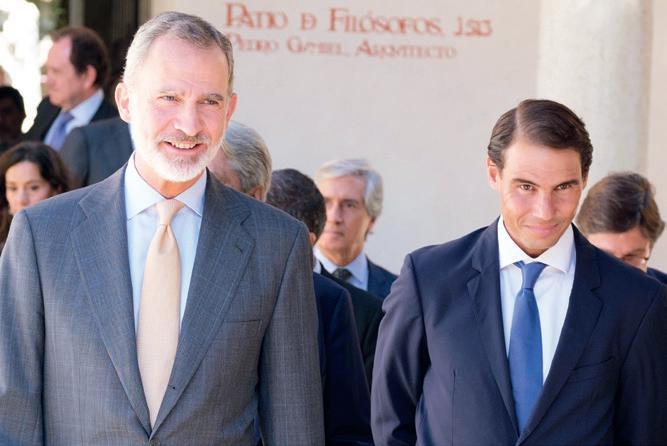
Others given titles - which ranks above an earl but below a duke - included pop-rock singer Luz Casal and Paralympic swimmer Teresa Perales.
The title, which can be inherited, is a symbol of gratitude for his role in promoting Spanish values of respect, excellence and self-improvement.


SEVEN rare US B-2 Spirit stealth bombers made a surprise radio call to Sevilla Air Traffic Control as they returned from bombing Iranian nuclear sites, highlighting Spain’s key role in global military operations. Refuelling over the Mediterranean, the bombers passed through the strategic Strait of Gibraltar – a vital chokepoint between Europe and Africa –before heading back to their US bases. Two flights were involved: BATT 11, with four bombers bound for Louisiana, and BATT 21, with three bombers whose destination was undisclosed.
The communication included routine checks on call signs, formation size and landing plans. Spain’s location puts it at the centre of global military logistics. The B-2s took part in strikes on Iran’s heavily fortified nuclear sites at Fordow, Natanz and Isfahan using massive bunker-busting bombs.
even claims Gibraltar has the second highest GDP per capita in the world
THE government has proudly announced a £9.7 million budget surplus for 2024/2025 – three times higher than projected.
The government posted revenue of £813 million, the first time it has exceeded £800 million, whilst GDP reached nearly £3.1 billion, with an impressive 6.5% economic growth.
The government claimed this gave Gibraltar, with a
By Walter Finch
pre-census population of 32,000, a GDP per capita of £96,875, second behind only Luxembourg.
More accurate calculations, however, would put Gibraltar’s population at approximately 40,000, resulting in a figure of
A FOUR-YEAR-OLD child has died after drowning in a swimming pool on the Costa del Sol. The incident took place at a house in La Alqueria, Mijas.

around £77,500, bringing it in around sixth globally. The minimum wage will increase by 60p to £9.50 per hour from August.
Public sector workers earning under £50,000 will receive a 5% pay rise, whilst the minimum public sector salary rises from £22,874 to £24,017.
Corporate tax came in £60 million higher than estimated, whilst tourist site receipts increased
Emergency services were called to the scene where they performed CPR on the young victim.
Sadly, resuscitation efforts proved unsuccessful and the child was pronounced dead at the scene.
from £9.1 million to £11.5 million.
Unemployment stands at just 16 registered Gibraltarians. The terri -
tory carries £500 million in COVID debt, giving it a net debt-to-GDP ratio of 21%. Cash reserves have increased to £268 million from £212 million in 2011.
Total departmental spending exceeded estimates by £66 million, mainly due to overspends in health and elderly care (£36 million), education (£11 million) and social security (£7 million). The public sector pay rise was included in this overspend as it was not initially budgeted.
Electricity and water charges increased by 2.4% from July, whilst all government fees will rise by 3% from August.
Pensions and disability benefits will increase by 3% in line with inflation.
A BRITISH holidaymaker has described the terrifying moment she was caught in what police now believe was a deliberate explosion at a Spanish tourist bar that injured 20 people.
Debbie Scholefield was shopping at the Lo Pagan street market opposite the Casa Javi bar in San Pedro del Pinatar when the blast happened. “It was like a bomb had gone off,” she told the Olive Press. “Glass and metal flew in slow motion and I was thrown forward. There were screams everywhere.”
Three people suffered serious burns, including the bar’s leaseholder, who remains hospitalised in serious condition. Investigations revealed deliberate tampering with a gas butane cylinder caused the blast. The bar, known for past incidents including a fire and frequent police callouts, has a troubled history and was reportedly operating as a ‘clandestine brothel’. Police are still trying to interview the bar owner, who was unconscious after the blast and reportedly ‘known’ to police. The investigation continues into what is now seen as an intentional act.

SPAIN could face more electricity blackouts this summer unless urgent steps are taken to stabilise the power grid, experts have warned.
The warning follows the April 28 outage, which plunged large parts
SPAIN is baking through an early summer heatwave, with Mediterranean sea temperatures soaring to levels more typical of late July or August.
Coastal waters are currently 3–3.5°C above average, while parts of the Med near Corsica and Sardinia are up to 5°C warmer, according to Eltiempo.es.
Figures from the Centre for Mediterranean Environmental Studies (CEAM) show sea surface temperatures reaching 23.5°C – unusually high for mid-June.
Buoys recorded 25–26°C in the Gulf of Valencia, Balearic Sea and southern Tarragona, while Mallorca hit 27°C – temperatures once reserved for August.
Experts blame the ‘tropicalisation’ of the Med on recent heatwaves and the lack of offshore winds, creating steamy, August-like conditions across coastal Spain.
The hot, humid sea air is fuelling powerful storms inland, bringing heavy rain, hail and strong winds.
Along the coast, residents are enduring tropical nights, where night-time temperatures stay around 25°C, with little cooling relief.
Cities like Alicante are suffering from the combined effects of warm air masses, cloud cover, urban heat islands and a warming sea –all contributing to muggy, sleepless nights.
Sea breezes, once a natural cooler, are now weakening as water temperatures climb.
Experts also warn the heat is damaging marine ecosystems, with native species struggling to survive and pollution compounding the threat.

17 YEARS OF ENVIRONMENTAL NEWS
Scan to find out more
of Spain and southern France into darkness. Investigators blamed a sudden imbalance in frequency and inertia. Though temporary fixes were introduced, such as boosting gas
but expert warns much more needs to be done
SPAIN has taken a major step in ocean conservation – but much more must be done to protect its seas, a leading marine scientist has warned.
Prime Minister Pedro Sánchez announced the expansion of Spain’s marine protected areas (MPAs) at the recent UN Ocean Conference in Nice, France.
and hydro generation, they are not sustainable long term and could hike bills.
Experts fear a repeat during sunny summer days when solar power dominates – and traditional generators, which stabilise voltage,

By Samantha Mythen
Currently, 21.3% of Spain’s waters are protected. But with five new MPAs added to the Natura 2000 network, that figure is expected to reach 25% by the end of 2025. The country is now edging closer to its goal of safeguarding 30% of its seas by 2030.
However, Oscar Esparza Alaminos, Marine Protected Areas Coordinator at WWF, cau-
are sidelined.
Officials confirmed a major overvoltage during the April incident. Plans to integrate renewables into voltage control are stalled in regulation, leaving the system exposed as demand soars.

tioned that most MPAs still lack basic management plans – and few are properly monitored.
“The next challenge is to move from promises on paper to real protection at sea,” he told the Olive Press. “The ocean gives us so much: over half the oxygen we breathe, climate regulation, and it’s home to more than half of all life on Earth.”
WWF supports the creation of MPAs to conserve biodiversity, block destructive activities, and build climate resilience. But without proper enforce-
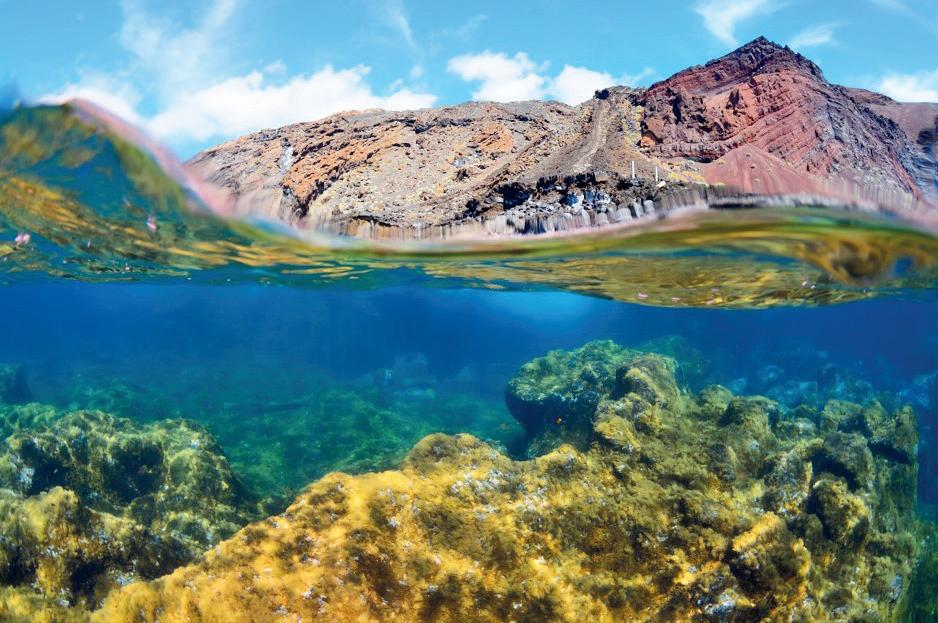
ment, Alaminos warned, ‘they’re just paperwork’. He said many sites – such as Cala Ratjada in the Balearics and the Medes Islands in Catalunya – are already acting as marine nurseries helping fish stocks recover.
“But they need to be science-based, well-designed, and enforced with input from all stakeholders,” he said.
The new MPA’s are the Mallorca
WARNING: Oscar Esparza Alaminos (left) says much more needs to be done to safeguard marine life
Channel Seamounts; the Seco de Palos Seamounts and Pitchmark Field; the Capbreton Tributary Canyon Systems; the Alboran Sea Banks and Gorges; and the Catalan Central Coast Marine Area.
Spain is also preparing to create the country’s first fully protected marine national park in the Mar de Las Calmas, off El Hierro in the Canary Islands. The law would protect vital ecosystems like black coral forests, as well as habitats for dolphins, whales, endangered loggerhead turtles, and the critically endangered angelshark.
Another protected area will be set up north of Menorca after conservation group Tursiops confirmed it was the only known breeding ground for sperm whales in the Mediterranean. Since 2019, 35 sightings of females and calves have been recorded there.
“It’s a unique opportunity to lead the way in marine conservation,” said Alaminos. “Hopefully it’s the first of many marine national parks.”
Spain has already made waves internationally. It was the first country to ratify the High Seas Treaty, backs a moratorium on
deep-sea mining, and is pushing for a global treaty on plastic pollution. An estimated 8 million tonnes of plastic enter the Mediterranean every year. Alaminos stressed that individual action is also key. “Tourists and citizens can help by making small choices that add up,” he said.
This includes using reef-safe sunscreens, eating local sustainable seafood, choosing eco-moorings over anchoring on seagrass, reducing single-use plastics, and taking part in citizen science projects like Observadores del Mar But he emphasised that real change must come from the top.
“It’s essential that governments match their words with action, and that MPAs are properly managed with local community involvement,” he said. “Strong institutions are key to holding them accountable.”
He also highlighted the need to control mass tourism in the Balearics and Canary Islands.
“We must balance tourism with ecosystems’ carrying capacity to ensure long-term sustainability,” he added.
“Protecting the ocean means protecting the foundation of life on our planet.”
Join the WWF Spain Philanthropy Club and visit conservation projects.
Next trip: Alto Tajo (Guadalajara), 3–5 October It’s a unique and committed way to care for the planet from the inside out.
Find out more with no obligation: wwf.es/club or club@wwf.es
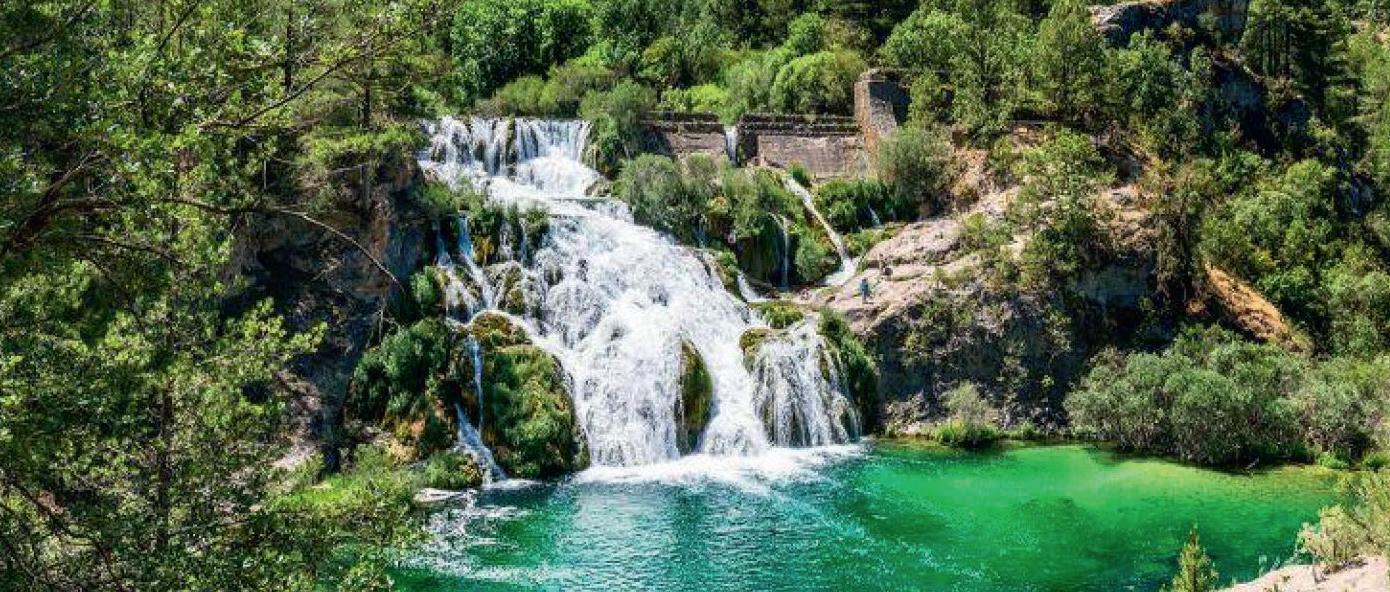


expat
A campaigning, community newspaper, the Olive Press represents the huge expatriate community in Spain with an estimated readership, including the websites, of more than two million people a month.
LA LINEA has big plans. And who can blame it?
So long the neglected, ugly step-child of Spain, deliberately starved of funds and investment out of – by all accounts – nationalistic spite from Madrid. They’d rather starve their own than see any of the crumbs go to Gibraltar, is the common refrain even uttered by the mayor of La Linea himself.
But for this dusty border town, so long trembling in the shadow of uncertainty cast by Brexit, suddenly the sun is rising.
The town can look forward to an economic lift from the coming treaty implementation and removal of the physical border.
But it dreams so much bigger.
A fully-operational international airport offers so much economic potential when paired with Gibraltar’s mighty service sector – and especially with the Port of Algeciras factored in.
They’re excited that one of the most depressed regions of Spain could transform itself into one of the most dynamic. This was what they were talking about when they repeated ‘shared prosperity’ over and over. So it all sounds good? Well, only with a willing Gibraltar.
A Spanish terminal could turn Gibraltar airport into a de facto Spanish airport.
Once up and running, the plane and passenger numbers would likely favour the Spanish terminal, effectively sliding Gibraltar out through the back door of their own airport.
Is this an erosion of sovereignty?
If that can’t be stomached, the boundary between the two jurisdictions would blur further if La Linea and the Campo succeed in attracting companies to take advantage of the new opportunities.
But Gibraltar retains its zero VAT on services, it retains its 15% corporate tax rate. These boundaries will not be blurred.
Gibraltar will be an even more attractive jurisdiction after the treaty is signed, and perhaps even more attractive again with a second terminal.
PUBLISHER / EDITOR
Jon Clarke, jon@theolivepress.es




Dilip Kuner dilip@theolivepress.es Walter Finch walter@theolivepress.es
Yzabelle Bostyn yzabelle@theolivepress.es
Samantha Mythen samantha@theolivepress.es
Tom Ewart Smith tom@theolivepress.es
Victoria Humenyuk Makarova (+34) 951 154 841 admin@theolivepress.es
‘I’ve got a good job at Ibiza airport but I have to live in a shanty town!’ O P LIVE RESS

By Jon Clarke in Eivissa
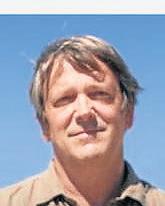
WORKERS on the party island of Ibiza have told the Olive Press the rental situation is ‘set to explode’. It comes as we discovered hundreds of them living in makeshift homes in scrubland just outside Ibiza town, or parked up living in vehicles.
To make matters worse, the authorities have recently started clearing one camp near the supermarket Mercadona and are threatening to clamp down on others.
At one rapidly expanding shanty town near the ITV (MOT) testing centre - as shown on Sky News last month - there are hundreds camped together.
It is the same situation close to the famous party resort San Antonio.
This week the Olive Press found a number of other smaller camps near Playa D’en
In the lee of blocks of luxury apartments costing upwards of half a million euros they showed us how they cooked on outdoor stoves and washed with water bottles.
Some who asked not
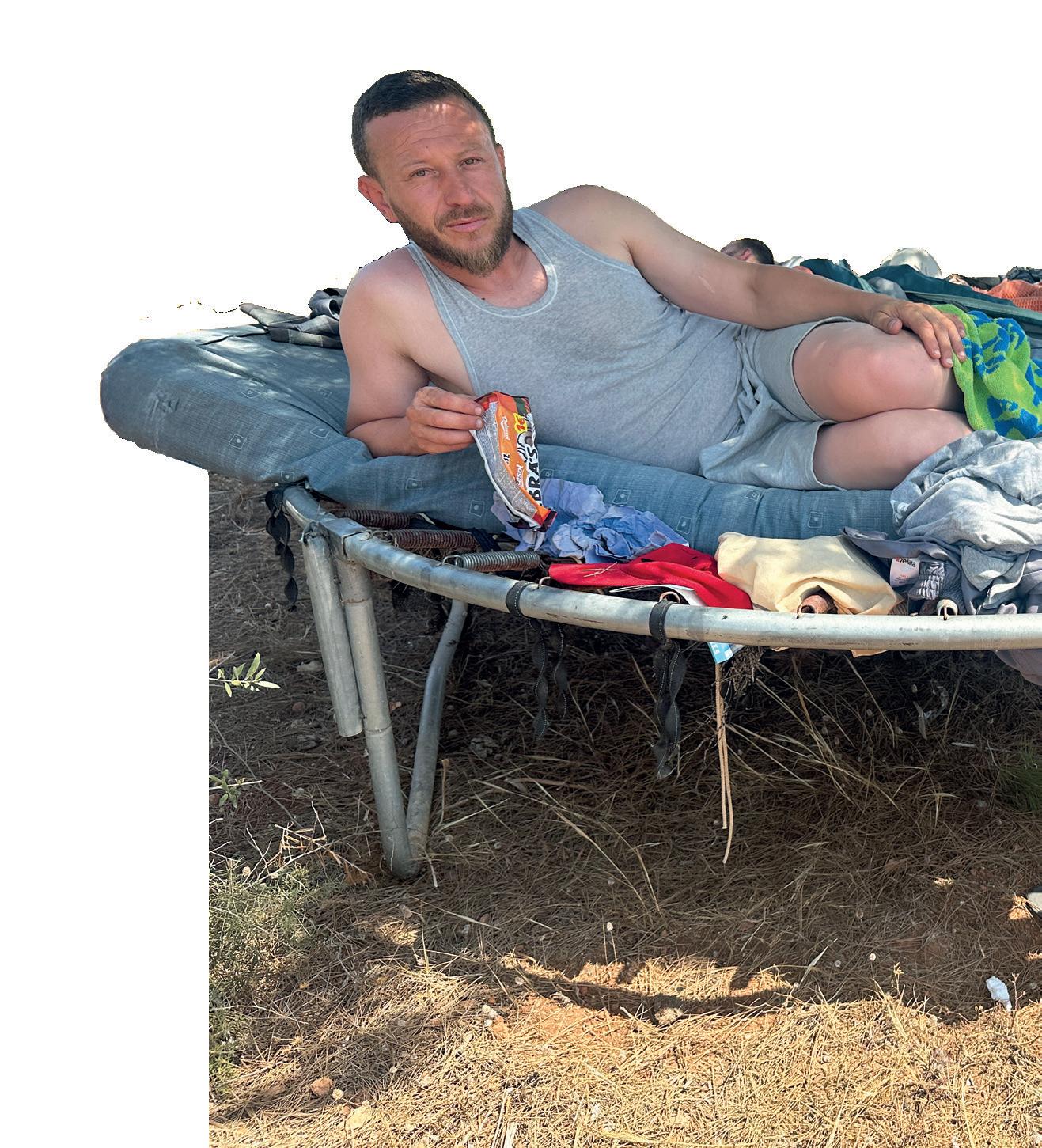
to be photographed had small children.
But these people are not Gypsies, travellers or illegal immigrants. They are legal European workers who have been hired on six month work contracts this summer.
I spoke to three employees - with well paid full time contacts - having to live in these dehumanising conditions.
They all blame the local and national government for years of under-investment in public or cheap housing. One, a Roma-
nian called Julio, 33, is in his second year working for a parking company at Ibiza Airport. Half asleep on a makeshift bed made out of a trampoline base under a tree on scrubland, his life was spread out in bags around him. A fellow worker slept in a bizarre car seat bed next to him.
Julio showed me his uniform and liveried cap (we are not naming the firm to protect him) before explaining: “It’s a decent, well


Alex Trelinski alex@theolivepress.es
Joshua Parfitt josh@theolivepress.es
Dylan Wagemans dylan@theolivepress.es
Estefania Marquez (+34) 658 750 424 accounts@ theolivepress.es



ENQUIRIES (+34) 951 154 841 distribution@ theolivepress.es

Deposito Legal MA: 834-2017





SOME names just linger in the background of our minds, like dusty old books on a shelf we’ve never opened. El Cid is one of those names.
Some of us know there was a Holly wood film about him (Charl ton Heston, brooding with a sword), others vague ly remem something about a Spanish knight, and the rest proba bly couldn’t pick him out of a line-up.
But here’s the thing: was real. He wasn’t just a film character or a class room footnote. His real name was Rodrigo Diaz de Vivar, and he died on July 10 1099 after living a life that would put most blockbuster plots to shame. He was born in Castile - north of Madrid, in a part of Spain where they still claim the ‘purest’ Spanish is spoken. If the UK has the Home Counties as its cul
As Cambridge University professor Nora Berend releases her Spanish language biography of El Cid, Michael Coy takes a delve into the life of the legendary figure
By Michael Coy

tural heart, this bit of Spain is its equivalent. Rodrigo was born right in the middle of it, and over the years he went from local lad to warlord to the ruler of Valencia.
But don’t let the ‘hero’ label fool you. His story is far from straightforward. Yes, he was a brilliant warrior. Yes, he inspired a famous medieval poem El Poema del Mio Cid). And yes, he eventually became a symbol of Christian Spanish virtue. But peel back the myth and what you find is a far messier, more interesting person.


Rodrigo - El Cid - was a man of his time, and his time was chaotic.

The Reconquista was in full swing, a centuries-long tug-ofwar as Christian kingdoms fought to re-

claim land from Muslim rulers across the Iberian Peninsula. And El Cid? Well, he didn’t always stick to one side. He fought for two Christian kings, Sancho and Alfonso. When that fell apart, and Alfonso banished him, El Cid shrugged and joined the other side - literally. He took up arms for Muslim rulers in Zaragoza, defending the very cities he’d once attacked. The name ‘El Cid’ itself comes from the Arabic As-Sayyid, meaning ‘The Master’. And he wore it proudly. At one point, he even launched his own campaign and seized Valencia, ruling it more or less independently. Not quite the holy Christian crusader of legend, then. More a ruthless, adaptable military leader who knew how to play both sides and win. He was, in modern terms, a mercenary. Loyal to no cause but his own survival and success. And yet, over the centuries, he was rebranded into a patriotic icon. Castile’s shining knight. The ideal Spaniard. It’s fascinating how stories shift like thathow someone can live one kind of life, and be remembered for another. Maybe it’s human nature. We like clean lines. Good versus evil. Heroes and
But real people, especially the interesting ones, rarely
into neat boxes. So what do we do with someone like El Cid?

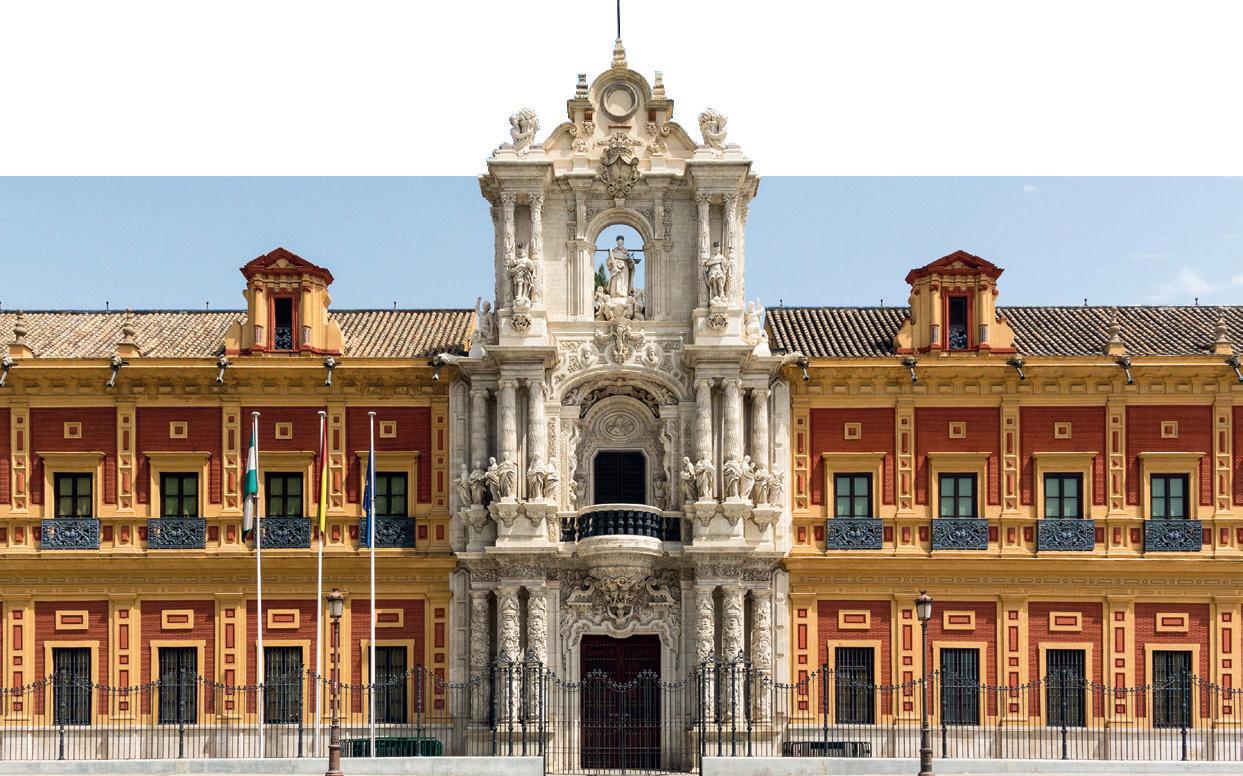
ASPECTACULAR new geological viewpoint has been unveiled high in the Cantabrian Mountains, offering jaw-dropping panoramas of one of Spain’s most dramatic valleys.
Perched near La Farrapona in the rugged Saliencia Valley, the sleek steel-and-wood platform was designed by Puerto & Sanchez Arquitectos after winning a public design competition run by Somiedo Town Hall under its Sustainable Tourism Plan.
Set at the highest point of the
valley, the lookout appears to float

ter with the region’s ancient rock formations – some of the oldest in the Iberian Peninsula.
The minimalist structure blends into its wild surrounds, with no flashy features – just pure mountain majesty and 360 degrees of raw geology.
The Spanish style that took Spain and the Americas by storm - and then died out
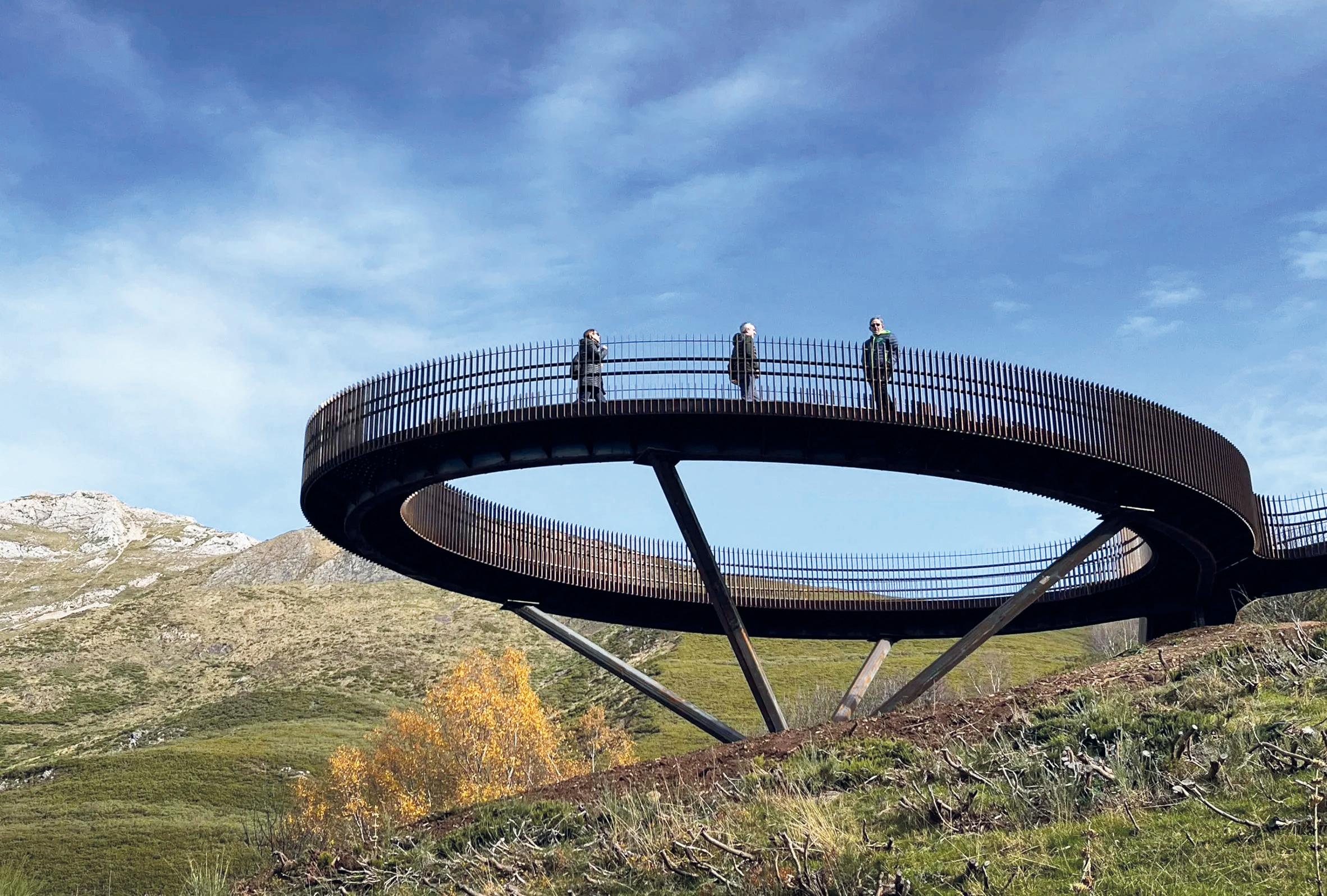
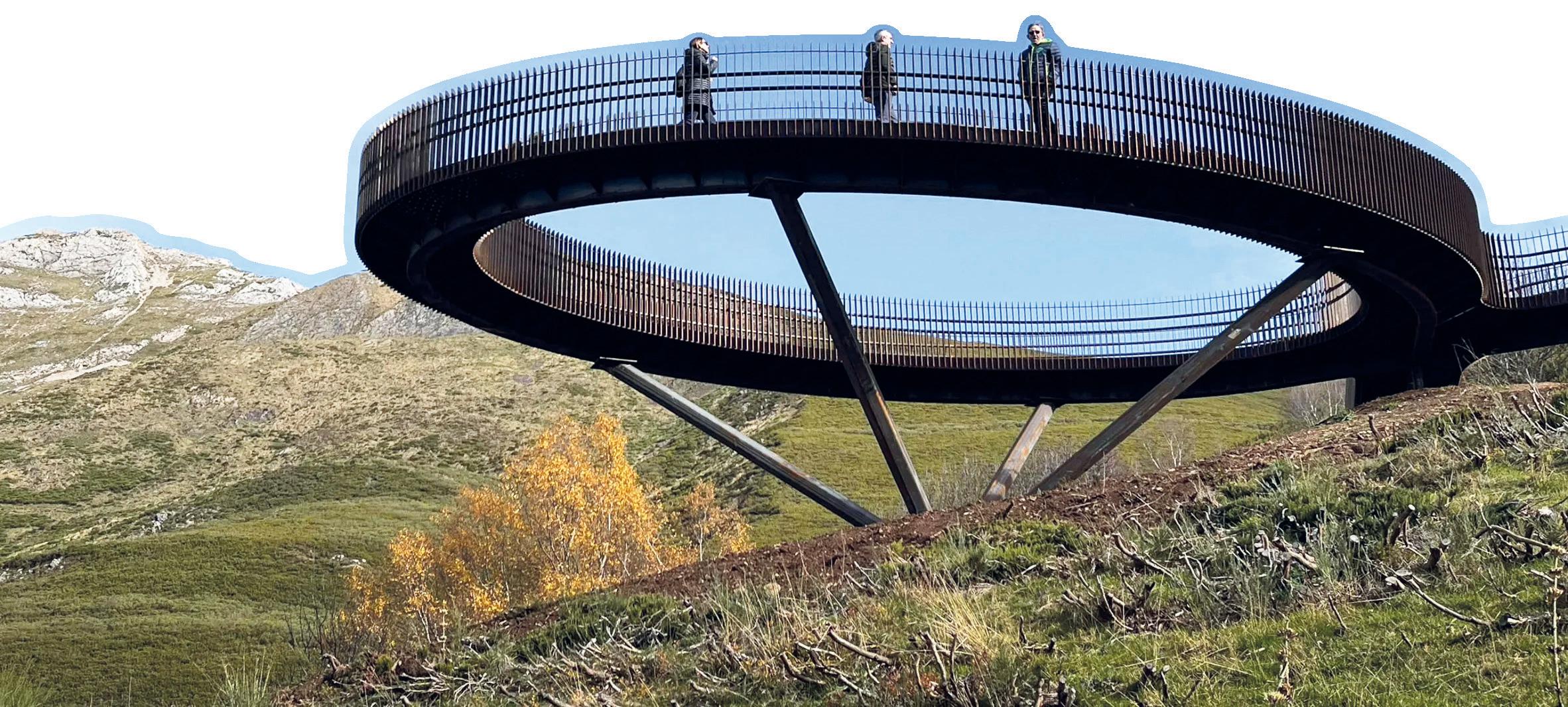

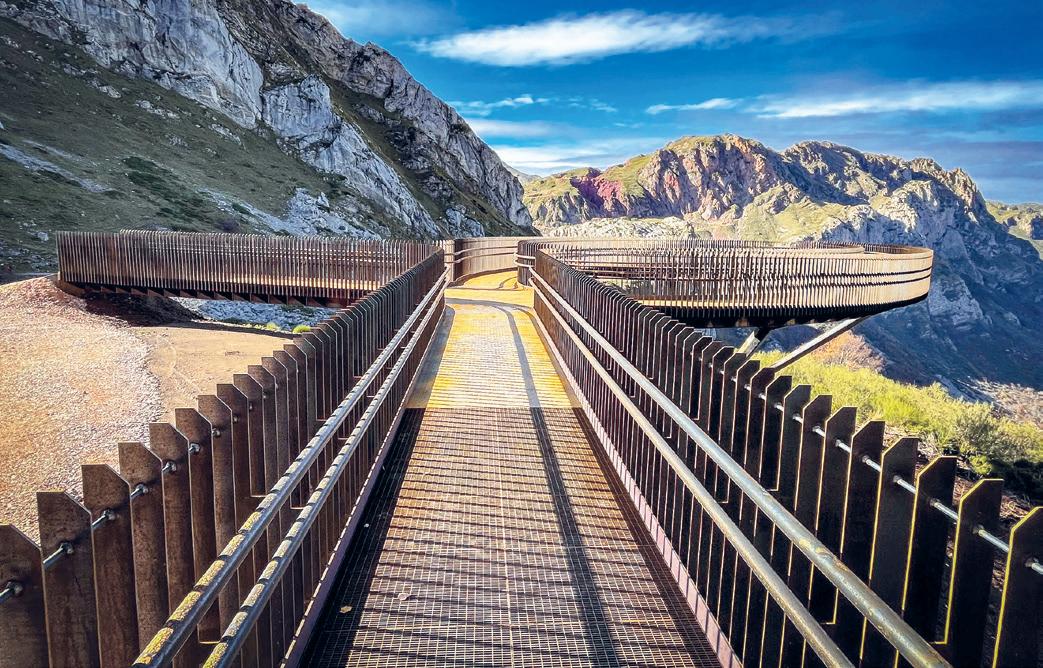
SPAIN’S high-end property market is showing no signs of cooling, with luxury home prices jumping an average of 15% over the past year.
According to the study looking at homes costing over €860,000 – the most dramatic price hikes have been in some unexpected places.
Oviedo, in Asturias, leads the charge, with prices rocketing by an astonishing 43% in just 12 months.
It comes as the historic city’s football team just got promoted back to La Liga for the first time in a quarter of a cen-
Spain’sluxurypropertymarketgoesloco aspricessoaracrossthecountry tury.
By Walter Finch
Guadalajara, near Madrid, follows with a 35% jump, while Madrid itself has seen prices climb 28% - pushing the capital’s luxury threshold (the top 10% of properties by price) to €1.85 million. San Sebastian meanwhile is up 26%, Lugo and Las Palmas are both up by 22% confirming healthy demand in both the north of Spain and the Canaries.
Palma de Mallorca remains Spain’s most exclusive market, where luxury homes now start at €2.1 million – the only city to cross the €2 million threshold. Barcelona showed more modest growth at 8%, with luxury defined from €1.29 million, while Malaga has officially entered the million-euro club, with prices starting at €1.045 million.
For buyers with tighter budgets, Zamora offers the cheapest entry point to luxury – just €240,000 – followed by Palencia (€290,000) and Huelva (€293,250).
At provincial level, the Baleares top the list with luxury homes starting at €2.95 million, followed by Malaga province (€2.2m) and Madrid (€1.56m). Ciudad Real ranks lowest, where €225,000 gets you a top-tier home in
the top 10%.
The surge is being fuelled by strong international interest – particularly from northern Europe – combined with domestic demand, low interest rates and ongoing economic recovery.
Only Soria saw prices fall, dropping 9%, while Ceuta remained flat. Toledo, Santa Cruz de Tenerife and Pamplona each posted modest 4% gains.
The study by portal Idealista looked at data from all of Spain’s provincial capitals and regions between May 2024 and May 2025.
The European Commission has taken a firm stance against Spain’s long-standing practice of taxing non-resident EU property owners more harshly than Spanish residents—a move that could spell good news for the thousands of EU citizens who own second homes in Spain and have long felt unfairly targeted by the Spanish tax system.
Brussels demands fair play for EU property owners in Spain
At the heart of the dispute is Spain’s imputed income tax on homes owned by non-residents that are not rented out. While Spanish residents enjoy an exemption for their main home, non-residents—including EU citizens—must pay tax on a notional rental value of
their Spanish property, even if it stands empty. The imputed income is set at up to 2% of the cadastral (rateable) value, and the tax applied ranges from 19% to 24%, depending on the owner’s country of residence.
Brussels argues this treatment amounts to discrimination, breaching core EU principles such as the free movement of capital and workers. After years of warnings, the Commission has now referred Spain to the Court of Justice of the European Union







Jenn Foster | Sales Agent
+44 754 796 2069
Jennifer@ERA-Costadelsol.com
Avenida Andalucia 21, 29679, Benahavis, Spain
(CJEU), citing both the imputed
EU takes Spain to court over discriminatory property tax rules that penalise foreign second-home owners
pital gains tax deferral as examples of unequal treatment.
Capital gains deferral: another unfair burden on non-residents
A second issue relates to the deferral of capital gains tax when a property is sold on instalment terms. Spanish residents are allowed to defer their tax liabilities in line with when they actually receive payments, easing the cash flow burden. Non-residents, however, must pay the full tax amount immediately, even if they won’t see the money for years. This effectively penalises cross-border sellers and, according to the Commission, violates the EU’s
A SWEEPING new housing package will hit foreign buyers, investment trusts (REITS) and empty homeowners in a bid to ease the housing crisis and prioritise long-term rentals for locals.
A new state tax, potentially as high as 100%, is set to apply to property purchases by non-EU, non-resident buyers.
So far there will be exceptions for those buying in the Basque Country and Navarra, while EU residents and VAT-registered professionals will be exempt.
Tourist flats offering stays under 30 nights in towns with over 10,000 residents will see VAT jump from 10% to 21%, aligning them with hotels.
legal framework. Spain has argued that its tax laws are consistent with EU law, but the Commission considers its response inadequate and has now escalated the matter to the CJEU.
Good news for foreign homeowners—and long overdue This legal action is likely to be welcomed by foreign homeowners in Spain—many of whom are retirees or holidaymakers from other EU countries—who feel they’ve been treated like cash cows by the Spanish tax authorities. Unlike residents, they’ve had to pay tax on properties that generate no income and face stiffer rules when se -
REITS (or real estate investment trusts) will face a tax hike from 15% to 25%, unless over 60% of their stock is allocated to affordable rentals. They will also be fully exempt if they reinvest profits into affordable housing within three years. A new progressive vacancy tax meanwhile, will penalise owners of empty homes.
This will stack on top of existing annual IBI taxes, with town halls encouraged to apply additional surcharges to unoccupied properties.

lling up.
If the Court rules in favour of the Commission, Spain may be forced to revise its tax legislation and bring non-resident EU citizens in line with residents. That could mean the end of imputed rental income tax on second homes, and fairer treatment when it comes to capital gains.
What happens next?
Spain now awaits its day in court. A ruling from the CJEU could take months, but if the court sides with Brussels, Spain will have little choice but to change its laws.
In short, this case could mark the end of what many see as institutionalised tax discrimination against non-resident EU property owners in Spain—something that has cast a shadow over cross-border property ownership for too long.
The government also wants to extend tax relief for energy-efficient renovations and to offer income tax breaks for landlords charging below official local rental prices.
Housing Minister Isabel Rodríguez explained the measures are necessary to tackle speculation, clamp down on illegal tourist flats, and bring homes back onto the market.
The proposals form part of Prime Minister Pedro Sanchez’s 12-point housing plan and are expected to be debated in Parliament in the coming weeks, The minority PSOE government will certainly need backing from other parties in order to get any of their plans into law.


November 29thDecember 12th 2023
MARBELLA is cementing its reputation as Spain’s luxury property capital, with a string of €20 million-plus mega-mansions hitting the market.
Three standout properties include Villa Olympus, which previously sold for €27.5 million in 2022, Villa Altos Reales, currently listed at €25 million,
and Villa Sierra Blanca, expected to come in above €20 million.
However, these eye-watering sums are still well below the record €70 million price tag on Villa Bellagio, as reported by Olive Press Property last edition. Prices per square metre have surged by over 60% in five years, driven by rising international demand and a younger, tech-savvy buyer profile, according to GC Studio founders Lucia Casaus and Alexis Gonzalez.

Let the train take the strain
SPAIN should invest heavily in regional public transport to ease its worsening housing crisis, say university researchers. Improved transport links could encourage people to live outside overcrowded cities like Malaga, Valencia and Palma. While places like Cadiz benefit from good tram-train connections, many provincial capitals lack decent options, forcing buyers to stay in pricey urban centres.
Experts from the University of Barcelona, Complutense in Madrid and University College Dublin have concluded that better regional transport would let workers access city jobs from affordable surrounding areas, easing demand and tackling housing bubbles.
They say this long-term strategy should complement rental controls and restrictions on speculative buying, helping redistribute population pressure and support economic growth in neglected regions.
SPAIN’S third largest bank
CaixaBank has launched a new online property portal called Facilitea Casa, offering more than 40,000 homes for sale or rent across the country. The digital platform functions as a marketplace where partner estate agencies can list and manage their properties, whilst CaixaBank provides financing support to buyers and renters regardless of whether they are existing customers.
The portal operates similarly to established platforms like Idealista, but with the key difference that CaixaBank will handle the mortgage and loan arrangements whilst partner agencies manage the actual property sales and rentals. The bank will not directly sell properties itself.
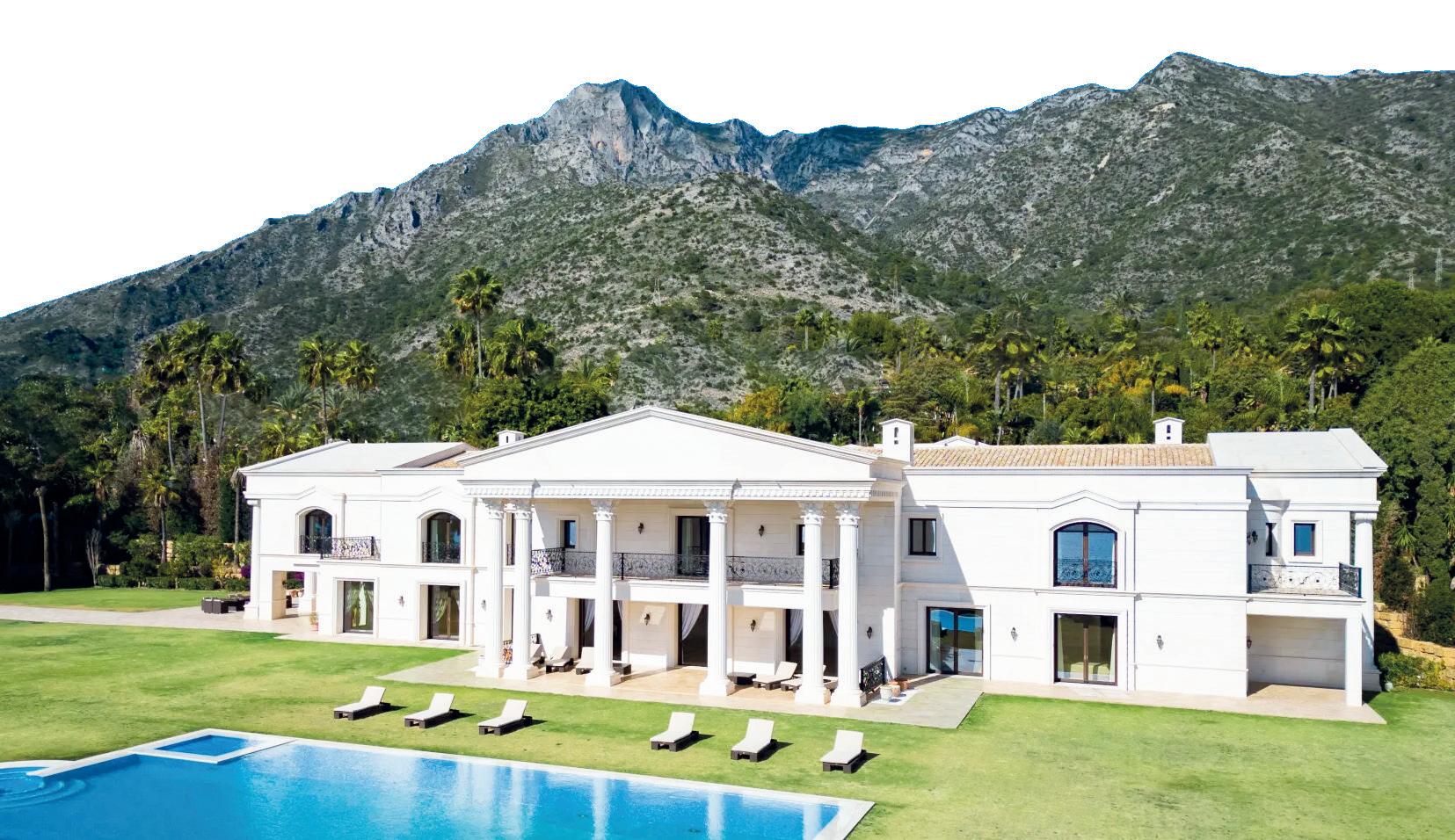
Villa Olympus, in Cascada de Camojan, spans 2,600 sqm across a 4,700 sqm plot and features seven en-suite bedrooms with natural stone, marble and limestone finishes.
Villa Altos Reales, on Marbella’s
Golden Mile, stretches across 1,400 sqm on a 4,000 sqm plot and includes seven bedrooms, a spa, gym, cinema, wine cellar and infinity pool.
Villa Sierra Blanca breaks convention with a single-storey design, offering
GERMANS have overtaken Brits as the top nationality applying for mortgages in Spain during the first quarter of 2025.
Figures from property portal Idealista show that 16.6% of foreign mortgage applications came from Germans, followed by 14.2% from UK nationals. Foreign buyers now account for 3.6% of all mortgage activity in Spain.
Applicants from Switzerland made up 8.7%, followed by the
By Alex Trelinski
United States at 7.7%. Next up are buyers from France (7.5%), the Netherlands (6.9%), Ireland (4.4%), Belgium (4%), Italy (2%) and Sweden (1.9%).
five bedrooms and energy-efficient features in the exclusive Sierra Blanca urbanisation.
Marbella's luxury market continues to attract high-net-worth international buyers. Recent developments have
included fashion-brand collaborations like those at Epic Marbella, with Fendi, Dolce & Gabbana and Karl Lagerfeld. GC Studio said Marbella is evolving into a hub of ‘exclusive, innovative projects tailored to global taste’.
Germans overtake Brits in mortgageraceasforeign demandstaysstrong
Idealista particularly noted the rising interest from Swiss and American buyers, with Dutch demand declining and French figures remaining stable. German applicants stood out for borrowing below the average, requesting around €148,946. By contrast, Swiss and American buyers typically applied for over €200,000, reflecting stronger purchasing power.
A LEADING property investment expert has warned against buying cheap flats in Spain as prices continue to soar.
Sergio Gutierrez, a real estate investment specialist, said the trend of influencers promoting €50,000 homes as easy earners could backfire on inexperienced investors. It comes as property prices hit a record €2,635 per square metre in May – a 14.8% year-on-year increase, according to portal Fotocasa.
Average salaries stand at €28,050 gross per year, while the most common salary is closer to €18,500–
€20,000, according to Spain’s National Statistics Institute. Gutierrez warned that bargain buys often come with hidden risks. “I keep seeing videos saying buy for €50,000 and rent for €500, and you’ll get a 10% return. It sounds easy, doesn’t it? But it’s not.”
His first warning is about tenant turnover. In low-demand areas, he said, landlords often face long vacancies between tenants.
His second concern is liquidity.
“These homes are hard to resell. That’s why they’re so cheap.”
But his biggest worry is a potential rental bubble. “Has nobody stopped

The average age of foreign applicants sits between 40 and 42, with Germans averaging 40. Foreigners request financing for an average of 74% of a property’s value. German applicants request 73%, while the
to consider that when this bubble bursts, those flats may rent for €300 and nobody will want to buy them?”
He also cautioned mortgage-backed buyers, saying losses could be severe if the market shifts.
Rental data backs his concerns. Madrid saw the steepest increases at 15.1%, followed by Aragon (14.5%) and Catalunya (13.8%). Extremadura remains the cheapest region at €9.90 per square metre.
With housing supply tight and wages stagnating, Gutierrez warned: “It’s not as easy as social media makes it look.”
French average 76% and the Swedes 71%. Coastal regions remain the top target for foreign buyers. The Valencian Community drew 26.8% of interest, followed by Andalucia (21.1%) and Catalunya (14.5%).
The most popular mortgage product among non-Spaniards is the fixed-rate loan, accounting for 84% of applications.
A HOUSING crisis is threatening to cripple public services in the Balearic Islands, with 45,000 affordable homes needed by 2030.
That’s the warning from Joaquín Chinchilla, president of APROVIBA, which represents small and medium sized developers across the islands.
“There are doctors and police refusing postings because rent costs more than their salary,” he said.
The islands already face a shortfall of 18,000 properties, set to grow as thousands retire in coming years.
Developers say red tape, construction costs and poor access to credit are stalling progress. Chinchilla criticised the regional government for failing to unlock housing via the Balearic Islands Housing Institute.
He backed using vacant properties and praised new policies allowing taller buildings and urban land reclassification.
“Declaring the archipelago a stressed zone is urgent,” he said.
Developers currently have 1,000 homes under construction but warn rising costs and labour shortages could derail progress.
See Homeless in Ibiza on page 6
UP to 150,000 rental properties could disappear from Spain’s longterm market by the end of 2025, sparking fears of a full-blown housing crisis.
The Secure Rental Observatory blames the sharp drop on Spain’s Housing Law, which introduced rent caps and stronger tenant protections.
As a result many owners have left the long-term market with numbers already down 17% nationally, while Barcelona has slumped by 46% and Cordoba 66%.
In some cities, dozens of families now compete for each listing and Ibiza many have simply given up trying and now live in vehicles or tents (see page 6/7).
Many landlords are turning to short-term holiday lets, which earn up to 400% more or are leaving homes vacant due to legal uncertainty.
Rents have jumped 24% in two years, while tenants now spend 47% of income on housing.
GOING solo in Spain isn’t cheap – especially in big cities or resort hotspots.
A new study reveals that to buy a studio, you’ll need to earn at least €18,080 net annually, plus have €40,480 saved for a deposit and fees.
That’s based on a 30% income-to-housing cost ratio, a common financial benchmark. Renting is even tougher. With studios averaging €800 a month, solo tenants should earn €32,000 a year to stay within limits.
In Barcelona, you’d need €47,000 – more than in Madrid (€40,880) or Valencia (€40,000). The most expensive cities to buy include Madrid (€32,160), Palma (€31,560) and San Sebastian (€27,480). Bargains can still be found in Santander (€9,240) or Ciudad Real (€10,040).
Across provinces, the Balearics and Madrid are priciest, while Zamora and Caceres remain affordable. The study underscores how tough it’s become for single people – especially young professionals – to live independently in Spain.
FROM the palaces of Spain to the cathedrals of colonial Mexico and the revivalist flair of early 20th-century California, the Churrigueresque style dazzled with theatrical excess and sculptural extravagance – a brief but unforgettable flourish in architectural history. Whether you find it breath-takingly beautiful, or over-the-top hideous, there’s no denying that the style has
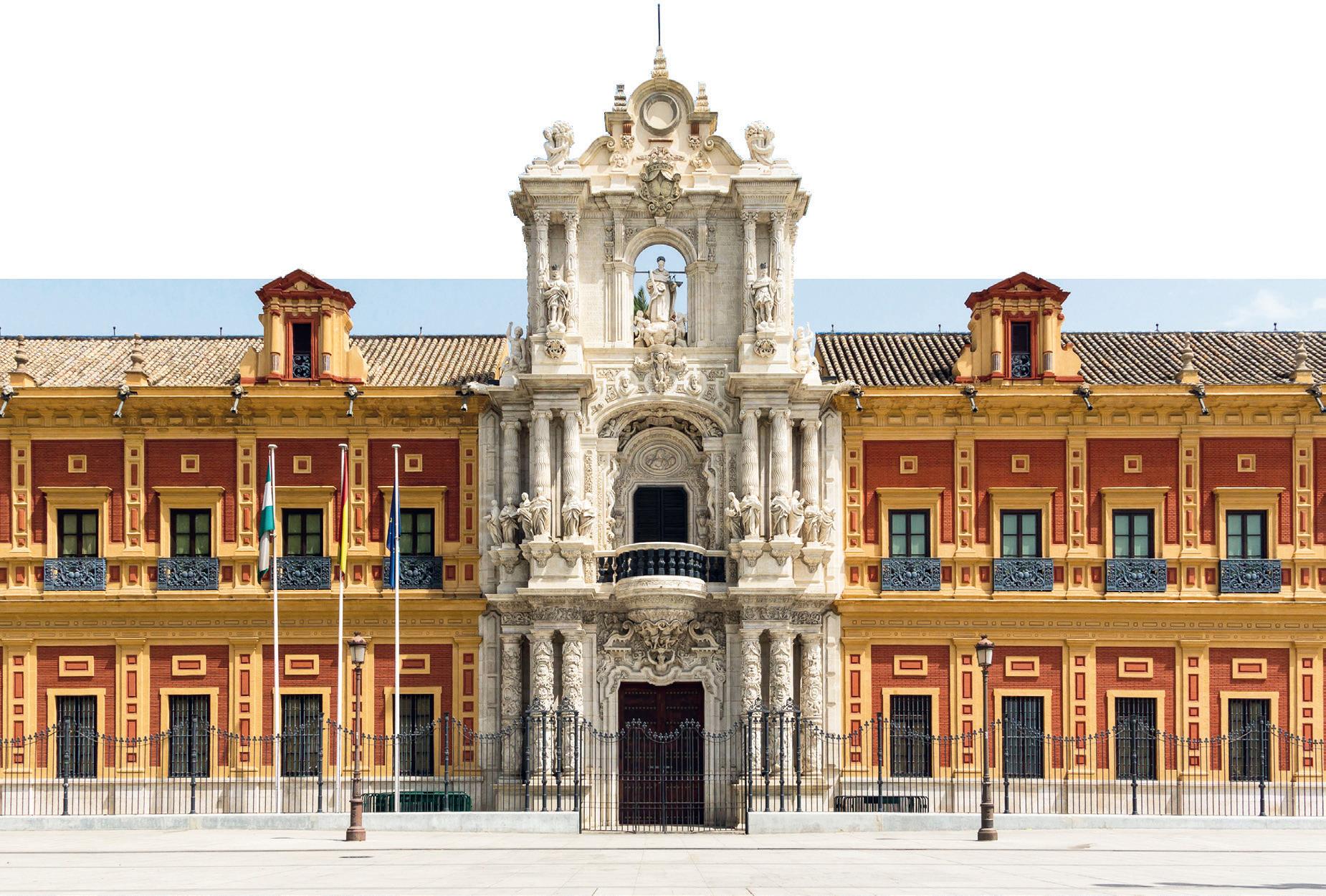
The flamboyant Spanish style Churrigueresque is known for its dramatic details, twisting columns and elaborate stonework that shaped churches and palaces from Spain
By Michael Coy

rely manifests itself on flat walls.
What Jose and his family were stri ving for was not ‘rustication’ (which refers to rough, textured masonry), but rather a radical reworking of classical ornamentation – manipula ting columns and entablatures into
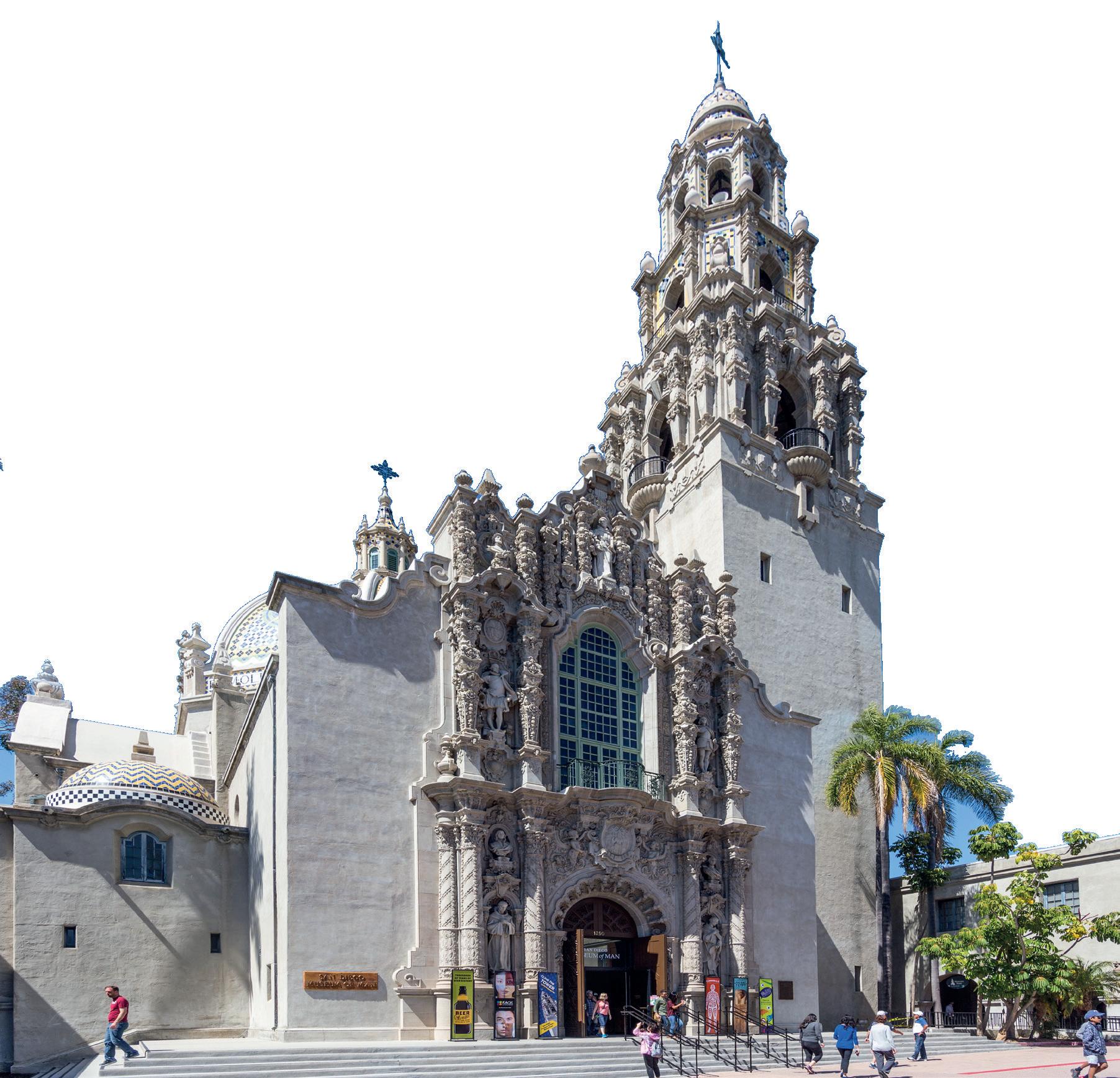


are to be found in Mexico. The Cathedral of Zacatecas and Santa Prisca in Taxco are outstanding specimens. What often happened was that Mexican churches like the Parroquia Antigua in Guanajuato stood unfinished for long periods of time. During the 18th century, these were often completed in grand style as money became available. When the Jesuits were expelled from Mexico and

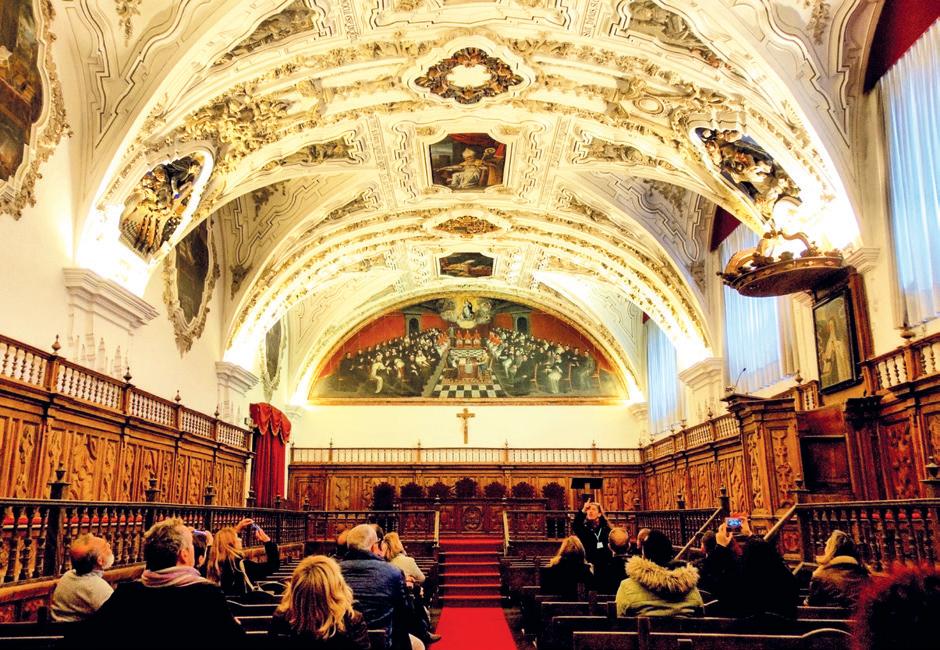

other Spanish territories in 1767, they left behind institutions, funds and architectural legacies that contributed to a wave of construction in the churrigueresque style. Improbably, this highly ornate ‘look’ made it into the 20th century. In 1915, there was a Panama–California ‘expo’, at which two American architects made playful forays into the Spanish–Mexican format, triggering a new craze.
Bertram Goodhue and Carleton Winslow developed ‘California Churrigueresque’, and many of their buildings still stand today in the city of San Diego. Could the style ever make another comeback?
We are reluctant to say ‘never’, but
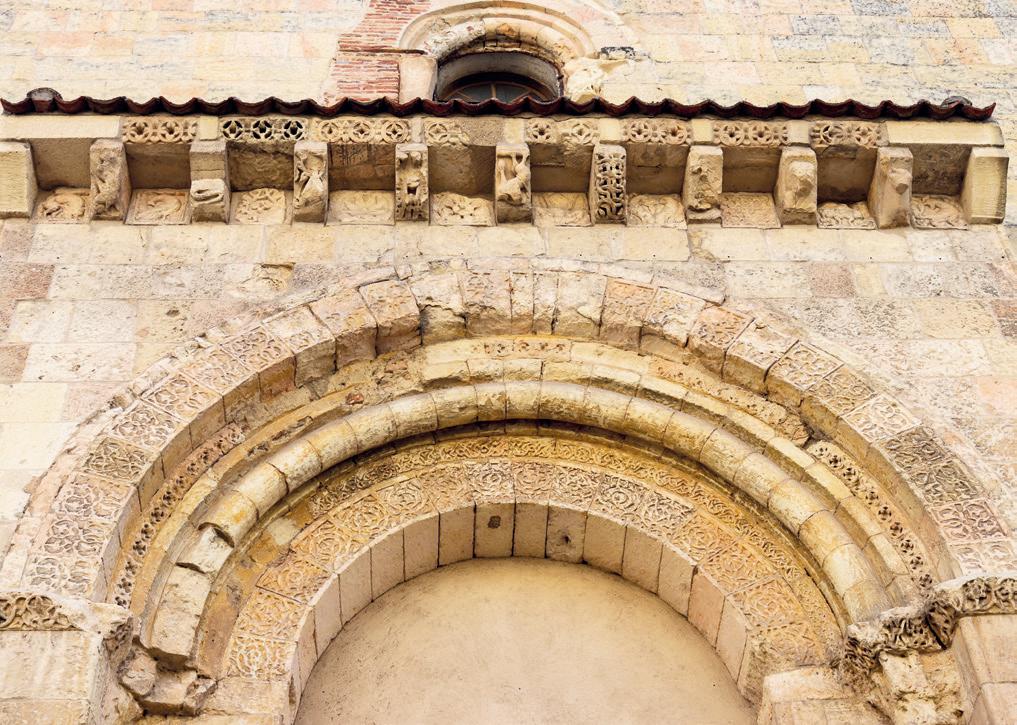
it seems unlikely. Modern materials do not lend themselves to protracted modelling. Furthermore, modern owners are cost-conscious, and do not see ornamentation as a high priority. Most important of all, churrigueresque was a form of ‘trompe l’oeil’ – an attempt to convince the observer that heavy stone is a light and nimble material.
Today we build lightly. There is no need to beguile anyone, and therefore no modern role for this hugely elaborate style.
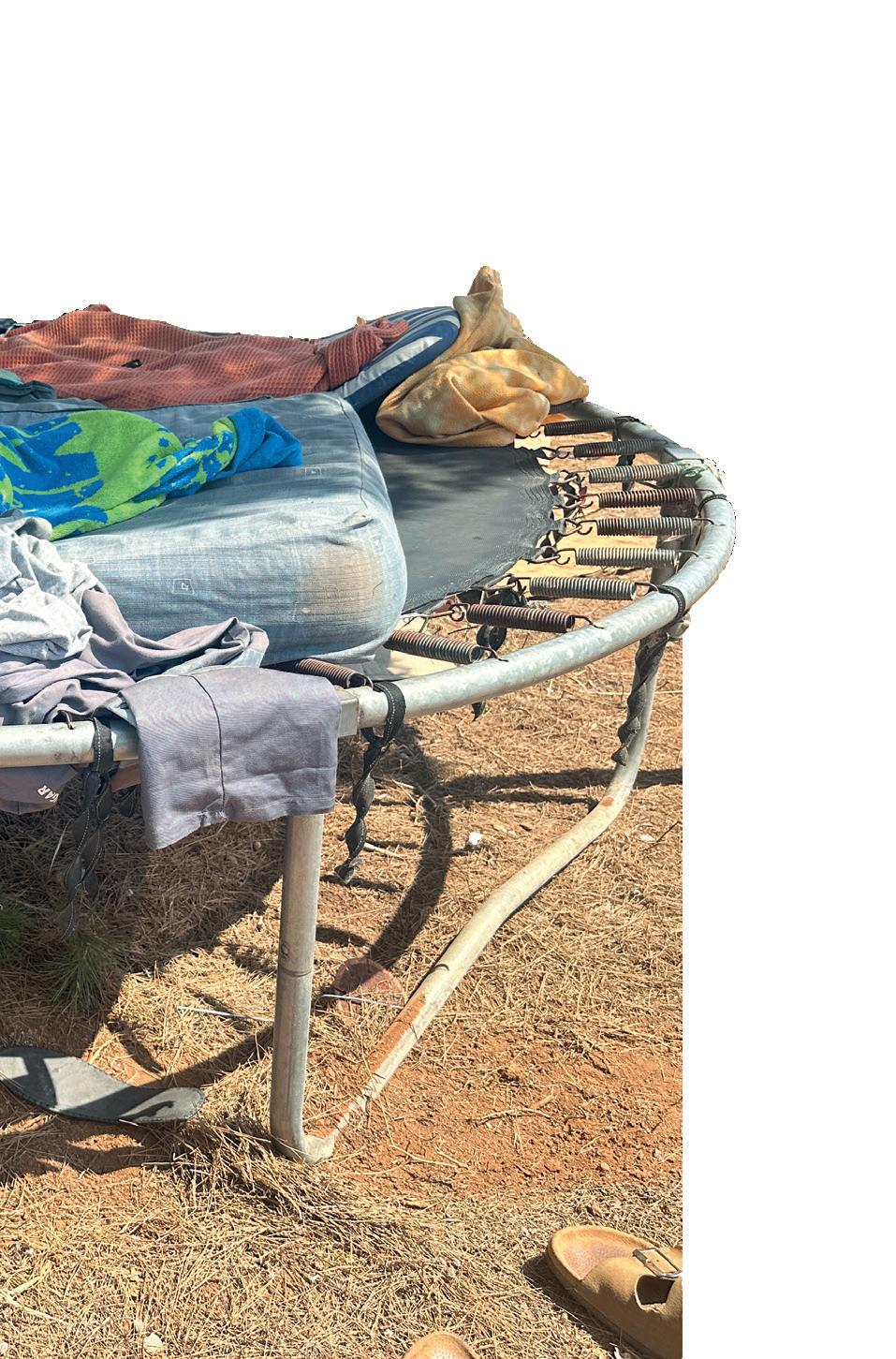
paid job and I like the work but it’s impossible to find somewhere to live.
“All the apartments I have seen are costing minimum €2,000 a month and the cheapest I found was a room for €1,000 in a shared flat with four others.
“By the time you’ve paid utilities there will be nothing left.
“Last year the boss of our company rented a big apartment for a few of the staff but this year he hasn’t, saying he can’t afford it.”
The father-of-two, whose family are back in Bucharest, continued: “The booming Spanish economy means there is lots of work. But at what cost?
“I’ve been thinking of moving over to Mallorca where I’ve heard it’s much easier to find a home.”
Another man living nearby in his car, alongside at least half a dozen others, told me he is a security guard at one of the clubs and has ‘no way’ to afford a flat.
The Morrocan, who insisted he was fully legal in Spain said: “There are some apartments with 12, even 15 people sharing, each paying

Maybe we can admire the skill, the tenacity, the sheer nerve it must’ve taken to stay afloat in a world constantly tearing itself apart. And at the same time, we can be honest about the compromises, the contradictions, the uncomfortable truths. He wasn’t perfect, but he was remarkable. If you ever find yourself in Burgos, you can visit his grave in the cathedral there. It’s a grand setting for a man who’s become larger than life. And as you stand there, maybe spare a thought for the real Rodrigo Diaz - hero, turncoat, warlord, legend. A man who lived by his own rules, and somehow still ended up a national treasure. Not bad for someone whose life can’t quite be pinned down.

€400/500. I’d rather be alone here.”
It has become such a problem that many hotels and restaurants are desperate to find employees as the season is beginning.
With up to four million tourists set to descend on the island this year and only 2,300 official holiday rental properties, the statistics don’t add up.
Too many foreign owners have stopped renting for the season and are renting short term via rental sites and word of mouth between ‘friends’.
“The number of illegal villas, apartments and rooms is impossible to calculate.
While fines of up to €500,000 can be imposed on illegal tourist rentals, some tenants are subletting via accommodation websites, with the real owners unaware.
The regional authorities insist they are working with Airbnb and Booking.com to clampdown.
Enrique Gomez Bastida from Ibiza Consell’s housing department told the Independent the rise of tourist villas and even extra rooms rented out in houses has stretched the island’s limited resources.
He admitted the soaring property prices have caused a housing crisis so severe that many municipal workers – including judges, police officers and medial workers – are now unable to afford to live there.
In March the Consell signed an unprecedented deal with Airbnb to remove 300 illegal rental homes from the platform.
asked to remain anonymous, told me he has recently resigned to drive a taxi.
“I was well paid managing a hotel restaurant last year where we should have had nine staff but we only had four or five,” explained the Ibicencan who has worked in tourism for ‘over 30 years’.
“It was so stressful - everyone was doing double the work and I had to pick up all the slack most of the time.
“It was impossible and this year will be worse for sure.”
Some hotel and restaurant owners have solved the problem by renting apartments - even entire blocks - to house their staff.
The owner of the island’s recently opened Nobu Hotel, Daniel Shamoon, confirmed to the Olive Press that his company, for example, had acquired enough property to guarantee fair rentals for its staff.
The dynamo behind dozens of hotels, including the Marbella Club and Puente Romano, described the situation on the island as ‘not easy’.
“One policy the island is attempting to tackle is the number of rental cars and people bringing their own cars to the island.
According to a source the Consell is about to charge people a euro a day to come over in their cars and vans to try to stop them living in them.

Get full ad-free access to our incisive website first-hand for just 50 cents a week with our special summer deal
WANT to stay ahead of the latest local news this summer?
Local news can directly affect your plans –from road and beach closures to weather warnings and fires, plus major local events, festivals and concerts.
The Olive Press helps you be the first to know what’s happening in your area and around the country.
Here’s why we are your best choice for local news in Spain. The Olive Press is trusted by the world’s leading media groups including the BBC, CNN, ITV, The New York Times, The Telegraph, Money Saving Expert and El Pais— - all have recently referenced us as an official source for Spain-based and expat-related news.
This month, our journalists, like editor Jon Clarke (left) appeared on national TV in Germany, America and the UK, while our stories ran in the Express, Independent and Mirror Leading global publications like the Guardian.co.uk have linked to and followed up OUR stories an incredible 34 times, while the Sun has done the same over 100 times. The Daily Mail links to 84 reports and America’s giant Vice. com some 40 times.
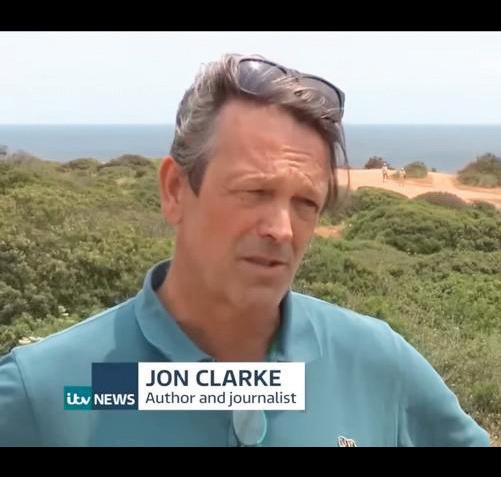
The Consell signed a deal with Airbnb to remove 300 illegal rental homes from the online platform Subscribe today — 50% off for 1 year.
Under the agreement moving forward, properties will now be removed ‘without discussion or appeal’, to stop costly legal delays.
But it has likely come too late for this summer.
One long time restaurant manager, who
Last month the Balearic authorities also sanctioned a law which means fines for illegal rentals will be reduced by 80% if owners agree to rent long-term as social housing.
In order to qualify, owners in Ibiza will have to rent them out for a period of five years via the Consell.
Prices will be set by the authorities with the most needy among the local 160,000 yearround residents being favoured first.

Meanwhile Rough Guides calls us the best English-language newspaper for your holiday in Spain, and we were voted Spain’s best expat newspaper by The Expat Survey Consumer Awards. And no surprise when one of young trainees Yzzy Bostyn just won the UK’s best young journalist of the year (2024) while working with the Olive Press in Spain. So we know you will get great value by taking advantage of our very special one off summer deal.
With your subscription:
● You get unlimited stories (non-subscribers get 2/ month)
● An almost completely ad-free experience
● Daily newsletters with the latest news in your area
● Specialist newsletters on travel, health and propert Willl you kick yourself for missing the news before heading out?

WIN TICKETS TO SEE ONE OF THE GREATEST SONGWRITERS OF ALL TIME
HE was the man behind Stairway to Heaven and Whole Lotta Love
The songwriter behind Led Zeppelin, Robert Plant is one of the true legends of rock, up there with Jimi Hendrix, Mick Jagger and the Beatles.
Now the Olive Press is offering our readers two pairs of tickets to see him play in southern Spain later this month.
Headlining the 1001 Festival in Granada, it is guaranteed to be an amazing night. His wide-ranging powerful voice is guaranteed to set alight the event on July 26.
To win, you need to be a registered pay user of our website.


SPAIN’S Supreme Court has upheld a law requiring employers who delay paying staff to pay 10% annual interest on overdue wages, reinforcing protections under Article 29.3 of the Workers’ Statute.
The ruling followed a case brought by 33 doctors against Sant Joan de Deu Hospital in Martorell, near Barcelona, for unpaid night shifts and weekend work between 2015 and 2019.
The hospital was ordered to pay €183,166.96 in back wages and €89,758.84 in interest.
Hospital management claimed public budget restrictions barred them from making these payments, citing a narrow legal exception.
However, the court rejected this defence, stating that budget limits do not equate to a legal prohibition on paying owed wages.
The decision makes clear that employers cannot avoid responsibility for late salary payments, and employees are entitled to compensation with statutory interest.
SPAIN’S government will allow the €11 billion BBVA hostile takeover of Sabadell Bank to go ahead, but under strict conditions that could see the bid being scrapped. The biggest caveat is that the two banks cannot be merged for at least three years, with an option for an extra two years.
No redundancies would be permitted at either entity during the period or changes to branches, i.e. closures.
The Economy Minister, Car

By Alex Trelinski
los Cuerpo, said the Council of Ministers approved the BBVA bid on the condition of ‘maintaining the legal personality, the separate assets and the autonomy in the management of both entities’.
“It is a decision that is proportionate, balanced and within the framework of Spanish regulations,” Cuerpo added.
The government announcement came after a public
PRIME Minister Pedro Sanchez claimed victory on Sunday after securing a last-minute deal with NATO, allowing Spain to remain in the alliance without meeting the controversial 5% of GDP defence spending target.
In an urgent address, Sanchez described the agreement as 'historic,' confirming Spain will

HIGH taxes and bureaucracy are reasons touted as to why Spain has dropped out of the top 10 in a foreign investment survey highlighting short-term deals of up to three years. Spain is now ranked 11th out of 25 large world economies according to the latest Confidence Index for Foreign Direct Investment (FDI) compiled by global management consulting firm Kearney.
consultation period launched in May.
Its terms mean that BBVA has a major decision to make over accepting the government demands; or to make a Supreme Court challenge; or to simply walk away from its Sabadell bid.
The BBVA chairman, Carlos Torres, previously said it would be ‘illegal’ for the government to impose extra
not have to increase defence spending to 5% nor meet that target by 2032. NATO leaders including Secretary-General Mark Rutte and US President Donald Trump had pushed the 5% goal amid rising tensions with Russia. Sanchez had threatened to veto the plan at this week’s NATO summit in The Hague, de-
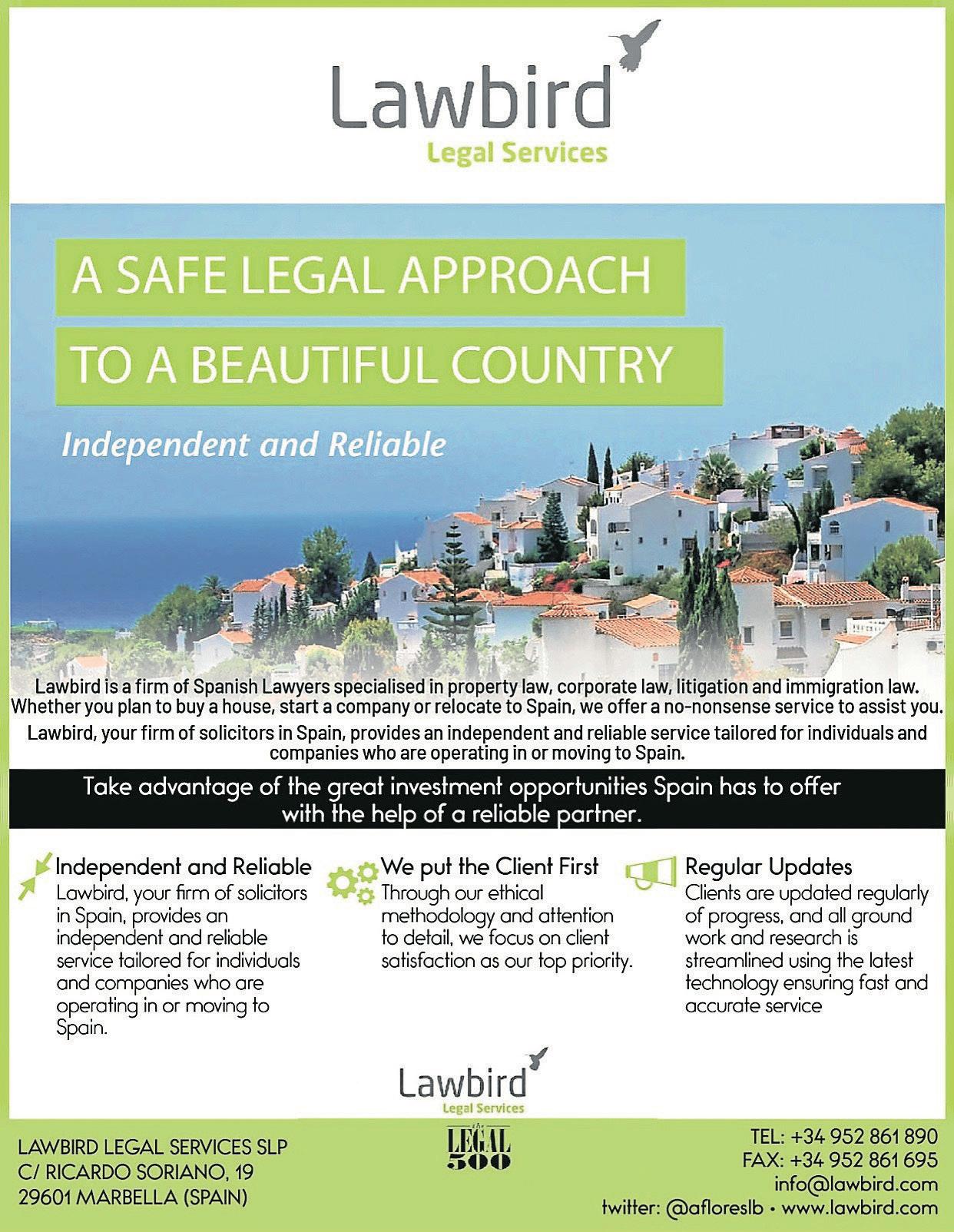
conditions.
He also said that if profitability was affected, the offer would be withdrawn.
BBVA had been preparing to launch its formal tender offer to Sabadell shareholders in the coming weeks.
Sabadell, meanwhile, has been looking to pay shareholders more to fend off the takeover by the potential sale of the TSB Bank in the UK.
manding an exemption from the steep rise from Spain’s current 1.3% defence budget.
Under the deal, Spain will set its own spending trajectory, with plans reviewed in 2029. Sanchez pledged to spend 2.1% of GDP on defence to maintain necessary capabilities, balancing security with protecting Spain’s welfare state.


The country has fallen three places in the last two years, having been in the top 10 since 2021 and has recorded an annual 13% fall in the index rating. Gregorio Izquierdo, general-director of the CEOE, which represents private and state businesses in Spain, believes the 13% drop is down to ‘legal uncertainty’.
“There is a delay and lack of effectiveness of legal processes including excessive tax litigation in our country and an insufficient defence of the right to private property,” he claimed. Though squatting is on the rise, it is still relatively minor, but Izquierdo said it ‘greatly damages the image of Spain over protecting property rights and it is something that we should avoid’.
Other factors put forward are regulatory complexity and excess bureaucracy with a 'tangle of regulations, obligations and licenses that do nothing but hinder business activity'.
DISCOVER the ancient art of bluefin tuna carving – or ‘ronqueo’ – at KOI restaurant in Marbella on July 3.
A team of experts from Barbate will expertly cut up the prized fish, caught nearby in Cadiz, using skills perfected over centuries.
HOTEL prices in Spain have surged 7% in the past year and are nearly 50% higher than in 2019.
This sharp rise, driven by strong post-pandemic tourism demand, limited hotel construction, and tighter Airbnb regulations, is making travel and housing more expensive.
Spain welcomed a record 94 million foreign visitors in 2024, a 13% rise from 2023, with over 100 million expected in 2025.
Eurostat reports a 70% jump in tourism since 2021, fueling the price hikes. In regions like the Balearics, where tourism makes up nearly half the economy, locals face rising housing costs
While tourism boosts GDP, experts warn of growing tension between economic gain and resident affordability.
Bluefin tuna regularly sells for millions, with a 278kg fish fetching a record $3.1 million in Tokyo in 2019. The ceremony will be followed by KOI’s

November 29thDecember 12th 2023
LOOKING FOR MORE TRAVEL STORIES?
Scan to visit our website
exclusive Omakase Night – a 10-course menu made from the freshly carved tuna. For €95 per person, guests get a glass of Champagne and a unique tasting experience. Spaces are limited, so booking ahead is recommended.



IF you’ve ever dreamed of seeing a flamingo on a motorbike, your moment has arrived.
A quiet town just 35 miles north of Malaga has gone full flamingo, launching a bizarre and brilliant new art trail featuring human-sized pink birds doing everything from cooking soup to checking on chicks. Fuente de Piedra, already famous for hosting Spain’s largest
PAMPLONA is bracing for carnage as the legendary Running of the Bulls charges into town on July 7. Each morning for nine days, six hulking bulls and six steers thunder through the narrow streets as thousands of thrill-seekers – decked in white and red – risk life and limb in the name of tradition. Immortalised by Hemingway, the 875-metre dash ends in the city’s bullring, where the animals meet a grim fate later that day.
Though no deaths since 2009, 15 have perished over the past century and many more are injured each year.


By Michael Coy
wild flamingo colony, has now gone a step further –by filling its streets with giant, human-sized flamingo statues.
Part of a fun new initiative called Pa’ flamenco, mi pueblo (‘Flamingo, my town’), the quirky trail features six-foot-tall birds doing everything from cooking soup to riding motorbikes.
The town, just 35 miles north of Malaga city, is home to the Laguna de Fuente de Piedra nature reserve, the biggest wetland in Andalucia and the top flamingo breeding ground

on the Iberian Peninsula. Now, with the new art trail linking the lagoon to the centre, the birds have taken over – in style. There’s a flamingo chef stirring up maja porra (a
TWITCHER: But this time it is the bird that is watching you
thick local tomato soup), one biker bird promoting the town’s July ribbon race, and a pair of lovebirds forming a heart for the perfect selfie spot. Families can follow the route, collecting letters hidden on each statue to spell out a mystery word and enter a prize draw at the tourist office.
“This celebrates both our natural treasure and the spirit of our town,” said mayor Siro Pachón, who hopes it boosts tourism year-round. There’s also a giant bench for family snaps, a flamenco-dancing bird honouring local hero Pablo Raez, and plenty of flamingo fun for kids.
A BAR worker in Spain has claimed their boss threatened to dock tips unless staff secure at least two customer reviews per day.
The anonymous complaint, shared on X by the account @ soycamarero, includes a screenshot of a message allegedly sent by a bar manager to their team.
In it, the boss demands staff pressure customers into posting reviews, warning that if they don’t hit 60 reviews a month, €10 per missed review will be deducted from their shared tips.
"If we don’t get sales now, by November we’ll have serious problems keeping everyone," the message reads.
"With 200 customers a day, I don’t think it’s too much to ask."
The post sparked outrage online, with one user replying: "Something similar happened to me in Avila – the waiter asked us for a review because he got a bonus. I found it regrettable."
November 29thDecember 12th 2023
LOOKING FOR MORE CULTURE STORIES?
Scan to visit our website
CONTROVERSY has erupted in Boadilla del Monte, a town outside Madrid, over plans to build the world’s tallest statue of Jesus.
The proposed monument would stand 37 metres high – seven metres taller than Rio’s famous Christ the Redeemer.
The project, backed by the Asociacion Civil de Devotos del Corazon de Jesus de Boadilla, aims to turn the town into a global pilgrimage site. Supporters say the statue will be a ‘beacon of hope’ welcoming all humanity. But opponents, including local
A BOTCHED restoration of one of Spain’s most sacred religious statues has sparked outrage among Catholics in Sevilla – with some calling it an act of ‘sacrilege’.
The Virgin of La Macarena, a 17th-century effigy housed in the Basilica de Santa Maria de la Esperanza Macarena, was unveiled after a five-day facelift ordered by the Hermandad de la Macarena brotherhood. But instead of joy, many faithful were left in tears, claiming their Virgin had been ‘disfig-
in
By Zoe Dahse

ured’. The makeover included a glossier finish to her face and dramatically lengthened eyelashes, prompting accusations that the sacred image now looked more like a celebrity waxwork than a revered icon. So fierce was the backlash that the Brotherhood attempted two hasty retouches within 24 hours – and has now apologised for the ‘moral and emo-
PSOE leader Alessandra del Monaco, argue the €17 million in public funds could be better spent and raise concerns over environmental damage and traffic near the motorway-adjacent site. If approved, construction could start in 2027 and finish by 2030.

TEARS: Worshippers shared the Virgin’s emotions after the ‘botched’ restoration (above)
tional damage’ caused. Despite the changes being subtle to the untrained eye, furious devotees flooded social media with memes and criticism. Many joked that the Virgin’s makeover drew more attention than PM Pedro Sanchez’s political scandals the same weekend.
The Virgin, carried through Sevilla’s streets during the city’s famous Semana Santa processions, has survived wars, fire, and dictatorship –but not, it seems, this ill-fated beauty treatment. The Brotherhood has since pledged to reverse the restoration.
FC BARCELONA fans can finally get ready to roar as the club confirms it’ll return to the iconic Camp Nou on August 10, 2025 - but don’t expect it to be quite finished.
After more than two years away, Barca will host the Joan Gamper Trophy at their famous ground.
Major work remains, including a new third tier, VIP areas and roof, but the club promises to keep fans comfy amid the building dust. When done, Camp Nou will hold 105,000 - Spain’s biggest stadium and one of Europe’s finest.
Elsewhere, Valencia CF today announced that the club had secured the full €322 million funding required for a new stadium, set to be one of the largest in Europe with over 70,000 seats, nearly 10% of which will be hospitality.
Club bosses hope that the state-of-the-art stadium will drive Valencia CF’s growth and unlock new long-term sustainable revenue streams that will strengthen the Club’s influence and competitiveness for decades to come.


SOMETIME around the reign of Emperor Nero, in the Roman city of Gades (now Cadiz), a man named Cinuras was laid to rest beneath a marble tomb.
The tombstone, likely paid for with his own hard-earned savings, bore an unusually bitter epitaph:
By Michael Coy

ly thought to be an isolated find has since revealed itself as a vast Roman necropolis: a sprawling ‘city of the dead’ that has remained hidden for centuries.
Today, Cinuras is just one of many voices rising from the soil.

the northern part of Cadiz. It was early January 2022, and workers doing renovations accidentally uncovered Roman fragments - just the beginning of a much
FASCINATING: A votive offering found at the site features a diagram of a foot

to afford a proper tomb. But the bitterness etched into his final words suggests that wealth and freedom didn’t buy him the peace he craved.
One tomb belonged to a woman who lived to be a 100 larger story. Thanks to subsequent funding and the involvement of professional archaeologists, what was initial-
he is - buried in a marble tomb, next to magistrates. That means he died a free man.”
That much is clear from his burial. Roman tradition did not allow slaves to be interred in such proximity to the city’s elite. It’s likely Cinuras was manumitted - freed after years of loyal service - and succeeded well enough
“We are giving voice to a man who otherwise would have remained utterly unknown,” Santos reflects. “It’s very beautiful. The way his family and friends treated him is forgotten now. What remains is a real
man, who really lived.” And Cinuras is far from alone. The archaeologists have so far unearthed 269 inscriptions, many of them rich with personal histories. One tomb belonged to a woman who lived to be 100 - an exceptional age in Roman times.
Others seem to cluster around what may have been a funerary college or even a temple, possibly dedicated to the Egyptian goddess Isis.


LOOKING FOR MORE CULTURE STORIES?
November 29thDecember 12th 2023
Scan to visit our website
15 July 2ndJuly 15th 2025

“We think this site was sacred to Isis,” explains Vazquez. “She was often worshipped in port cities like Gades. People probably came here regularly to pray and wanted to be buried near a place they loved.”
Small terracotta statuetteshand-held offerings likely left by worshippers - support this theory. So too do faint wall paintings showing birds and reeds, symbols linked to the Nile and Isis’s mythology.
“This wasn’t a luxurious temple,” Santos adds, “but a local, working chapel. It served real people, and they came back here in death.”
In total, the team has documented 55 burials so far, ranging from simple pits cut into dunes to ornate marble tombs dating from the 4th century AD, when the necropolis appears to have been abandoned.

Remarkably, many of the tombstones were found stacked like playing cards, suggesting someone - long after Rome’s fall - had preserved them rather than destroy them.
“That kind of care is rare,” says Santos. “Normally, they’d be smashed or repurposed. But here, someone saw their value. Thanks to them, we now have this incredible archive of lives.”

The work is far from over.
Vazquez and Santos believe the site could fundamentally reshape how we understand Cadiz’s place in the Roman world.
Far from being a sleepy outpost, Gades may have been a centre of cultural exchange and spiritual significance.
“The investigation is just beginning,” Vazquez says. “And we’re probably going to make some overwhelming discoveries.”
But even now, before the full picture is known, the rediscovery of Cinuras feels like a quiet triumph.
A man who once lamented being forgotten is now, against all odds, remembered - his story a voice from the grave that still has something to say.

Across: 7 Karate, 8 Atomic, 9 Stun, 10 Irritant, 11 Beaded, 13 Danube, 15 Reform, 17 Cosmos, 18 Egg white, 20 Lame, 21 Quayle, 22 My word.
Down: 1 Wait here, 2 Pawn, 3 Denied, 4 Paired, 5 Contends, 6 Lion, 12 Doorways, 14 Bloomers, 16 Mailed, 17 Creamy, 19 Go up, 20 Lewd.


26 JULY CONGRESS CENTER ROBERT
PRESENTS SAVING GRACE FEATURING SUZI DIAN 24 JULY CONGRESS CENTER







CARLOS Alcaraz paused his Wimbledon match to aid a fainting fan in 32C heat, offering water before sealing a five-set win over Fabio Fognini in a four-hour epic.
A UK TikTok star has slammed Marbella as a haven reserved for ‘fraudsters, drug dealers and footballers’, warning average people can’t afford face €20 Red Bulls, €50 entry fees and €1,500 table minimums.
FOOTBALL boss Luis Rubiales has avoided jail after the National Court upheld his €10,800 fine for the controversial non-consensual kiss of footballer Jenni Hermoso after 2023’s Women’s World Cup final.
FORMER Spurs winger David Bentley made waves in Puerto Banus this week – quite literally – after being spotted partying on a jet ski while getting served… from a yacht. The retired England star, 40, was seen zooming around outside the Marbella marina with a grin as wide as his crossing range, pulling doughnuts and spraying tourists.
In a moment worthy of a beer ad, Ian Radford - boss of local celeb haunt La Sala - lobbed a can of cold beer from a swanky yacht to the jet-skiing footballer – who impressively
caught it one-handed.
“He’s still got the touch!” one onlooker shouted, as Bentley cracked it open midride and toasted the crowd like
Ex-England ace goes full throttle in Banus beer bonanza
By Dilip Kuner
a sunburnt James Bond. Now a Marbella regular and co-owner of La Sala, Bentley looked like he was enjoying retirement as much as his Premier League days – minus the defending.
Locals say he’s become a fixture in Banus, but few expected the former England winger to be playing keepy-uppy with a San Miguel while straddling

JUICED UP: But the guava had hidden cocaine
a jet engine. As one beachgoer put it: “Only in Marbella.”
Eyewitnesses claimed the waterfront crowd gave a cheeky round of applause, while one British holidaymaker asked if Bentley was audi-

GRINNING: Bentley gives a wave while Radord steers, before the ex-Spurs star took over
tioning for the next Fast & Furious film
The stunt reportedly sparked a wave of copycat jet ski antics – none of which ended with such style.
IT sounded like the ultimate wellness hack for the high-flying elite - a smoothie that could fuel a finance bro’s 3am club cameo AND his 6am gym session.
But Spanish authorities have juiced the dream, uncovering a cocaine lab in Valencia where criminals were extracting cocaine base hidden inside
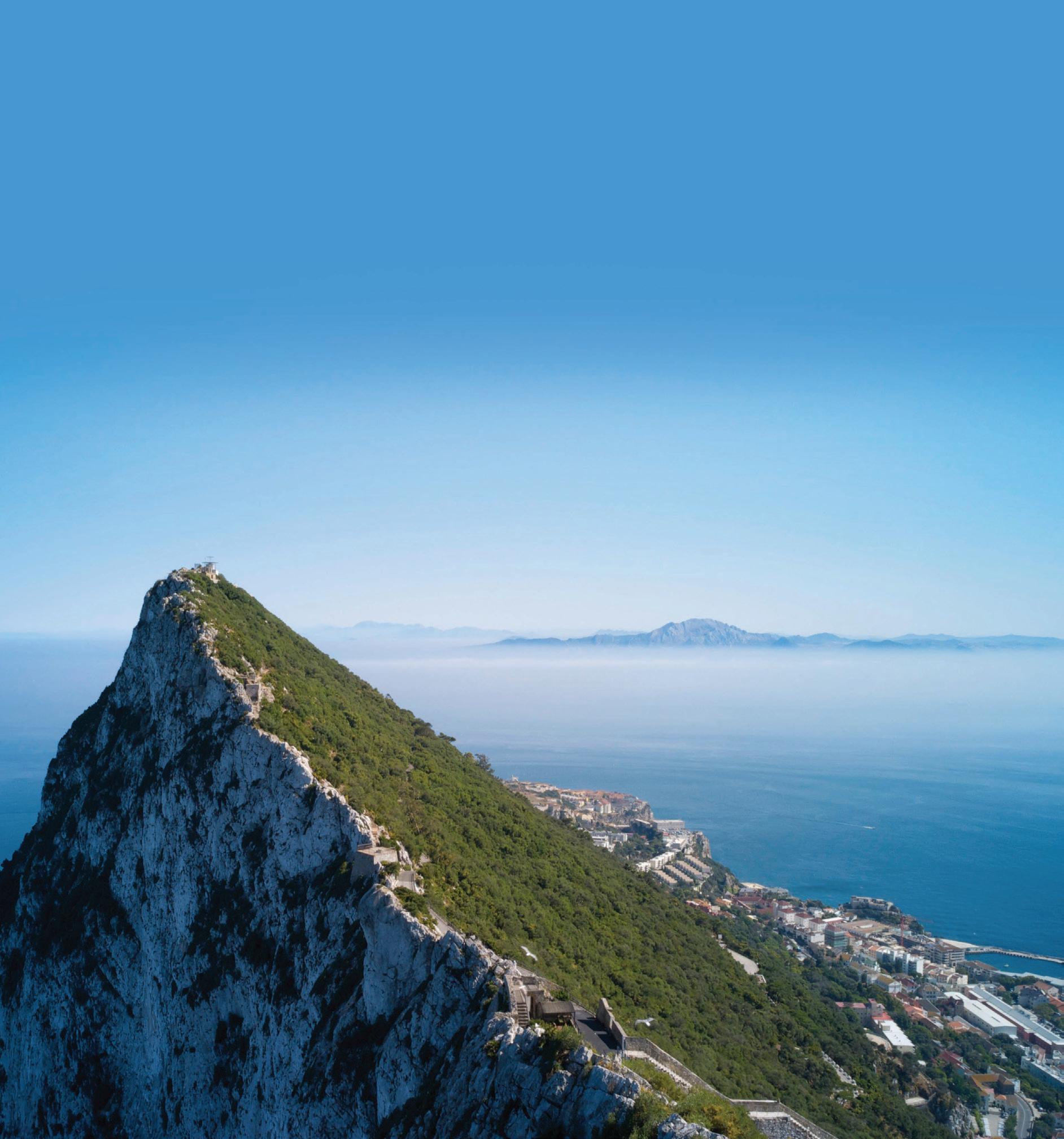
SPANISH boffins will have a new best friend as they decommission a nuclear power station - a robotic dog called Spot. The high-tech pooch, built by Boston Dynamics and tweaked by tech firms GDES and Alisys, is on a mission to sniff out any sneaky leftover radiation hiding in walls and floors.
The plant’s been out of action since 2012, and now Spot’s joining the decade-long tidy-up, sending live data back to boffins so humans don’t have to poke around in the radioactive muck themselves.
The project involves the development, testing, and commissioning of the robotic system, along with training for Enresa personnel who will eventually operate it.
drums of frozen guava pulp - perhaps the ultimate fruit smoothie for a certain type of health conscious junkie.
In a sting operation codenamed ‘I. Amable/Sunka/Zafra’ (which frankly sounds like a niche juice bar), police and customs agents dismantled a narco network ca-
pable of ‘cooking’ up 30 kilos of cocaine a day. Some 25 arrests have been made.
Police suspicions were raised when shipments of industrial drums of tropical fruit, imported through a legit-looking food company, were paid for by a man who had oodles of cash despite apparently living off unemployment benefits.

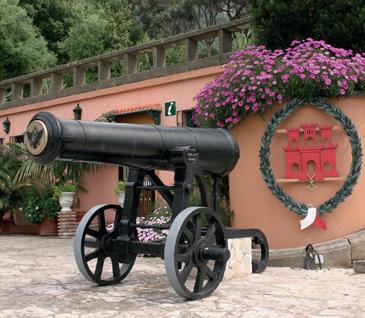

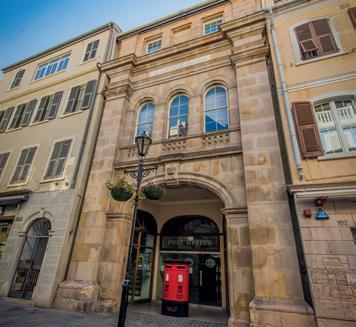
With a UNESCO world heritage site offering 120,000 years of human history and only short drive from the Costa del Sol, enjoy the warmth of the British Gibraltarians and splash out VAT-free in Sterling.
Gibraltar. Sun, sea and history served with a very British twist.
For further information call: Gibraltar Tourist Board +350 200 74950
Or to download a brochure go to: www.visitgibraltar.gi